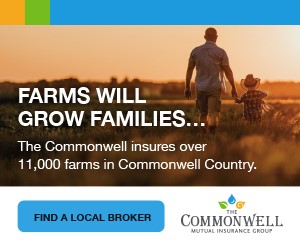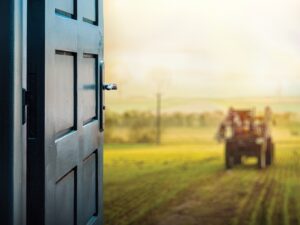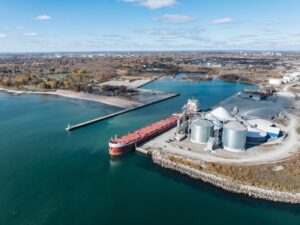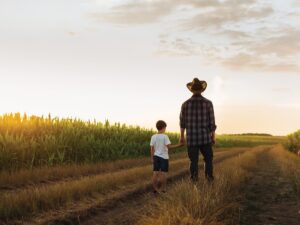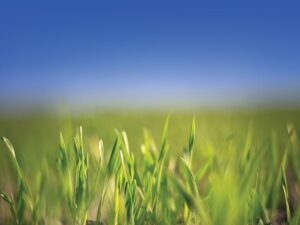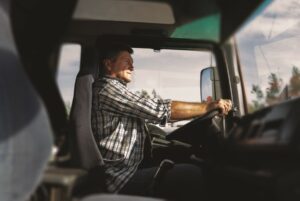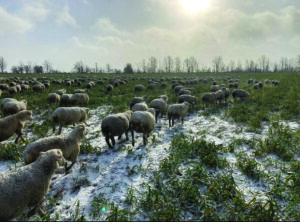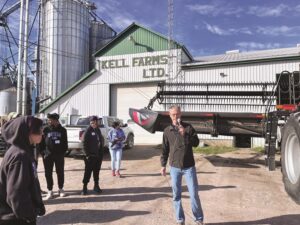Field Observations
SUMMER 2025
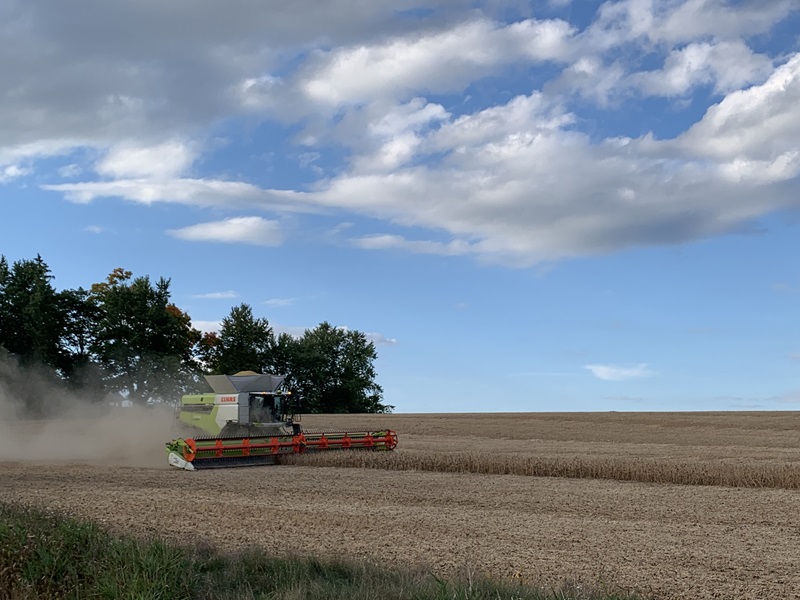
September 18, 2025
With ideal harvest weather, soybeans have begun to come off across much of the province, where crop stage allows. Winter wheat planting is ongoing, and the corn crop is seeing milk line progression towards black layer.
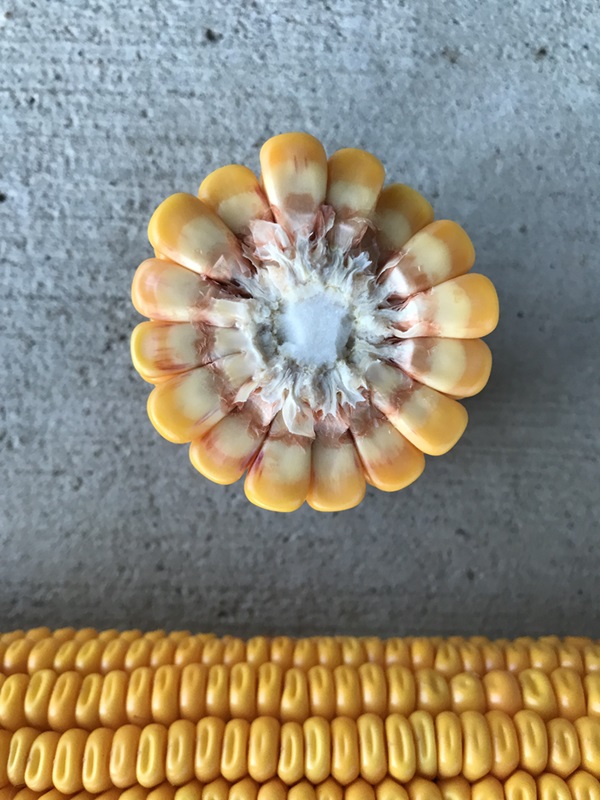
Corn
Corn milk line progression is around the ¼ to 3/4 milk line. Warm weather will help see steady progression, with corn still in the kernel dent stage (R5), with black layer approaching (R6). The long-range forecast predicts lots of sun and warm temperatures, which should significantly help bring this corn crop along.
The corn harvest has just begun on acres that were impacted by the summer’s drought in central Ontario. More on harvesting corn affected by drought can be found on a recent Grain Farmers of Ontario webinar.
Poor stalk integrity can begin to show up during this time of the year. More on what to look for and how to manage here.
Soybeans
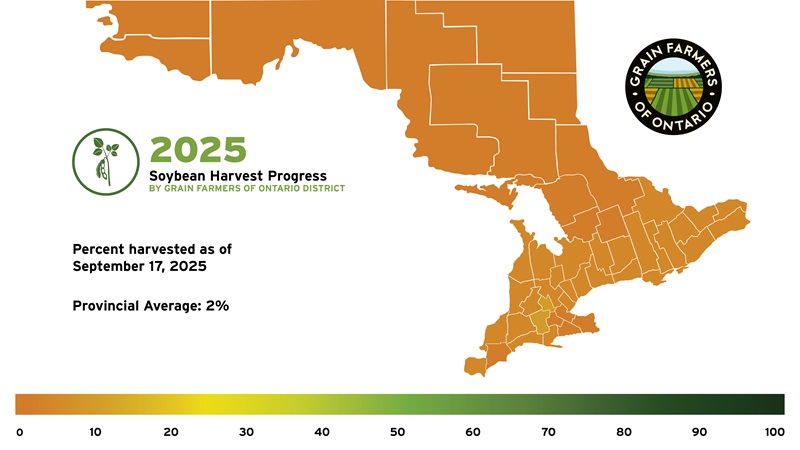
Soybean harvest has begun across most of the province.
Grain Farmers of Ontario recently launched Field Progress—your go-to source for weekly estimation on planting and harvest progress across the province, by district. Soybean harvest is two per cent complete by Wednesday, September 17, 2025.
Warm weather is ripening the soybean crop quickly. It might be the case this year, as it has been in others, that some farmers are surprised at how low moistures are, (reports of soybeans down to eight percent harvest moisture), as the soybean plant had just matured, but with lower humidity and soybean seed maturing before full plant death, dry seed moistures can occur quickly.
When soybeans are under 13 per cent, elevators don’t adjust the weight up for dry soybeans, so shipping too dry soybeans is like giving a percentage of your beans away for free. Even paying a little bit for drying charges and taking a bit of shrink for wet soybeans just to get them off the field and in the bin is always worth it compared to weight lost to dry soybeans and delayed harvest. Also, future weather predictions are sometimes incorrect for clear days to harvest, so waiting for perfect moisture at 13 per cent may not happen on many fields. By getting the soybeans off the field in a timely manner, it also allows wheat to be planted earlier and in better soil conditions without ending up mucking in the seed later in cooler conditions when seasonal weather occurs. Overall, earlier planting, with a higher yield potential, is the key.
A reminder to make sure that residue from the combine is evenly spread across the field to ensure ideal wheat planting conditions.
When scouting fields before harvest, take a close look at the pods on the plant. Are there more pods on the top or bottom of the plant? A story can be told—fewer pods on the bottom of the plant show that drought was earlier in the year, as flowers or pods on that portion of the plant were aborted. This year, some are seeing larger/more pods higher up on the plant, which shows that soybeans can compensate a bit due to a long flowering period. Some will also see larger soybeans, too, if there are fewer pods, as the plant sinks more energy into the limited pods/beans.
Now is a great time to scout fields for weed escapes, to better prepare for next year’s herbicide decisions. Paying particular attention to identifying waterhemp and its similar look, Palmer amaranth. If there are weeds of concern that you can’t identify, consider getting them identified by a local agronomist or connect with Mike Cowbrough, weed specialist, OMAFA.
Cereals
Winter wheat planting has begun in some areas in order to have wheat planted in optimum timing, with 1 per cent complete as of Wednesday, September 17, 2025.
Spring cereal harvest as of Wednesday, September 17, 2025, is 91 per cent complete. Northern Ontario has been experiencing some wet weather over the past week, so the spring cereal harvest has been at a standstill.
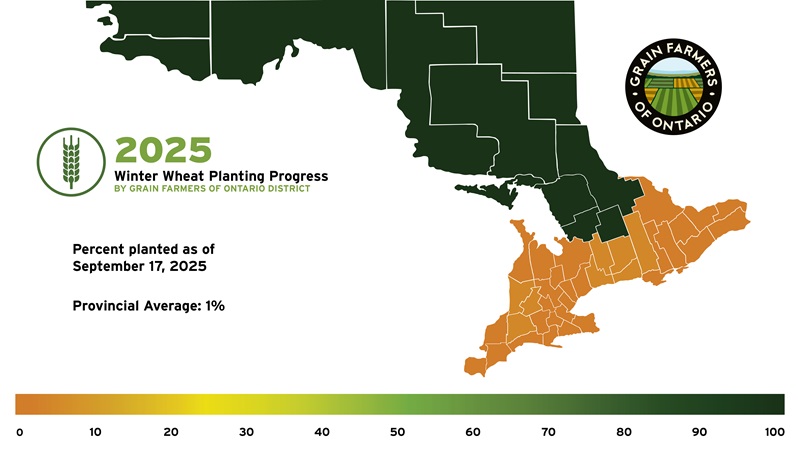
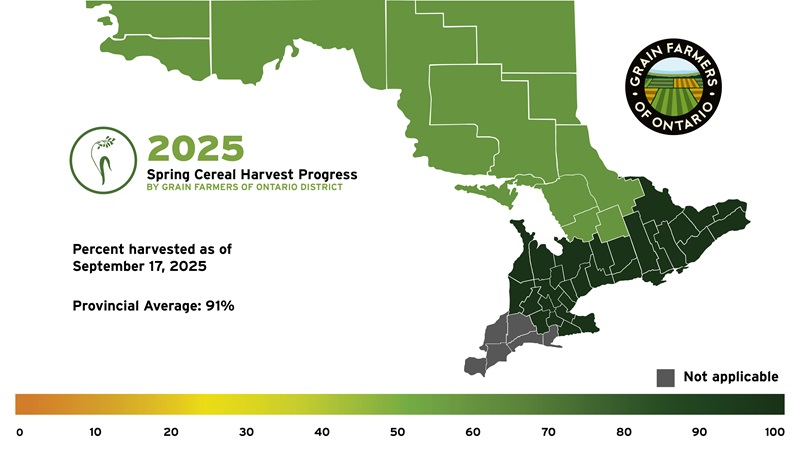
If planting winter wheat much earlier than the optimum planting date, backing off on the population is advised, as good plant growth and tillering can be expected with the warmer fall that is predicted. If planting at ideal dates, the population should be at normal levels. Later planting dates will require higher populations to compensate for reduced plant growth and fewer tillers. Planting populations range from 1.2 million to 1.8 million seeds per acre, depending on planting time, soil type, and management. Always check your seed source and adjust the population depending on the tested germination. If planting by pounds per acre, as that is how the drill is set up, make sure to check the seed size and adjust how many pounds you are seeding. Based on the variety and environment where the seed was grown, seed lots can vary up to 3,000 seeds per pound. If seeding 103 pounds to the acre this could mean close to 400,000 seeds per acre difference. Which in turn could mean a too thin stand or a way too thick stand that may get more disease and be more prone to lodging. Be sure to adjust the planter.
Safety
This time of the year is extremely busy. Keep safety at the top of mind. As harvest progresses remember to adhere to bin safety measures (don’t enter alone, remember to lock out/tag out, wear a mask and goggles) refresh bin safety awareness here.
Allowing a bit of extra time for harvest and planting can help reduce stress on farmers and employees and potentially allow for more rest. Fatigue on the farm can be as dangerous as impaired driving. Take time to take breaks as the busy harvest season approaches.
September 11, 2025
The spring cereal harvest is 91 per cent complete. Soybeans in some areas are nearing maturity, while corn is accumulating dry matter in the kernel.
Corn
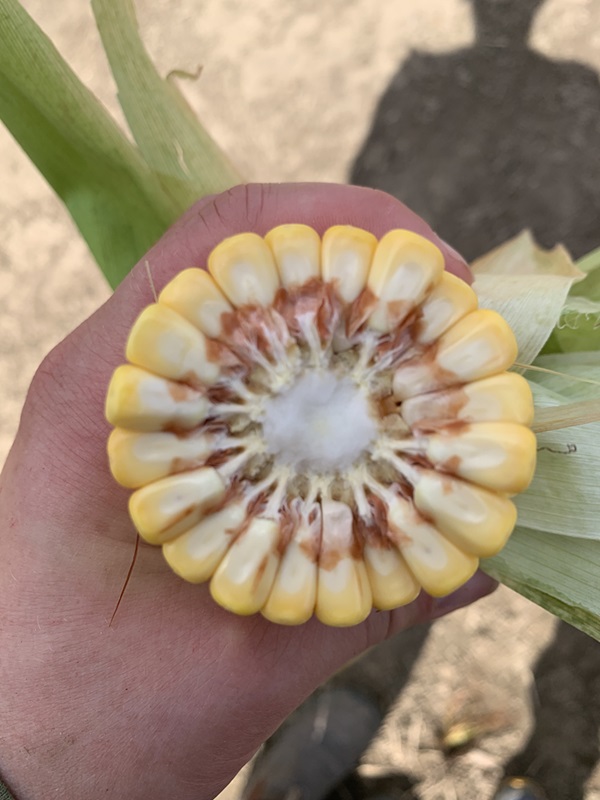
Corn is staging up to the early kernel dent stage (R5). The milk line disappearance has progressed this past week, with warmer daily temperatures helping to accelerate the process. However, cooler nights can slow or halt crop progress. Fields will be approaching the quarter-to-half milk line. At the half-milk line, the kernel is roughly 35 to 40 per cent grain moisture. Once the milk line moves all the way down the kernel, the black layer will form, stopping the movement of any starch into the kernel. Some early fields could be reaching black layer (physiological maturity) in the next few weeks. Once black layer is reached the kernel is roughly 32 per cent moisture.
Earlier this week, some areas received overnight frost; luckily, it sounds like most did not receive a damaging frost. However, if plants die due to frost or disease before black layer, yield loss can be observed, along with a lower test weight, as the kernel tips will shrink. Overall, it all depends on how early in the grain fill the killing frost arrives. A killing frost, drought, or disease-causing death before true black layer (milk line at 100 per cent) that kills the entire plant causes concerns with grain dry down, as grain does not have the abscission layer to block migration of moisture in the kernel. Cobs that have good kernel depth and hard, dense starch that is packed into the kernel throughout the grain fill period will add kernel weight to maintain maximum yield potential in the field.
Southern rust has been identified in the deep southwest. Warm (27 °C), humid, and wet conditions in mid to late summer are ideal for this disease’s development. So, while tar spot has not thrived in the summer this year (due to environmental conditions), it was ideal for southern rust development. More from OMAFA here.
As harvest approaches, as shared last week, DON in corn is something to be aware of. Below are some resources on DON management.
General information:
- Factsheet: DON in Corn
- A comprehensive overview of DON mycotoxin and the resources available to manage its effects.
- Ontario Grain Corn Ear Mould and DON Mycotoxin Survey (Expected release: Mid-October 2025)
- Published by the Ontario Ministry of Agriculture, Food, and Agribusiness (OMAFA), this annual survey provides an early assessment of DON presence in Ontario corn. The survey will be posted on Field Crop News.
Corn Hybrids:
- Ontario Corn Hybrid DON Screening Trials Report (Expected release: Late 2025)
- This report – updated annually – offers vital data on the susceptibility of various corn hybrids to DON, assisting in both harvest decisions and seed purchases. The report will be posted on GoCrops.ca when it is available with 2025 data. Currently, 2024 data is available.
Proper DON testing procedures:
- Factsheet: Testing for DON
- Developed based on the findings of the DON Working Group, this guide outlines best practices for obtaining accurate DON test results. It emphasizes the importance of collecting a representative sample of at least two kilograms and grinding it to the correct size.
- Video: Accuracy in Testing for DON
- A step-by-step tutorial demonstrating best practices for accurate DON testing.
Storing mycotoxin-affected corn grain
- Factsheet: Storing mycotoxin-affected corn grain
- A comprehensive document that discusses harvest, drying and storage of mycotoxin-infected grain corn.
Soybeans
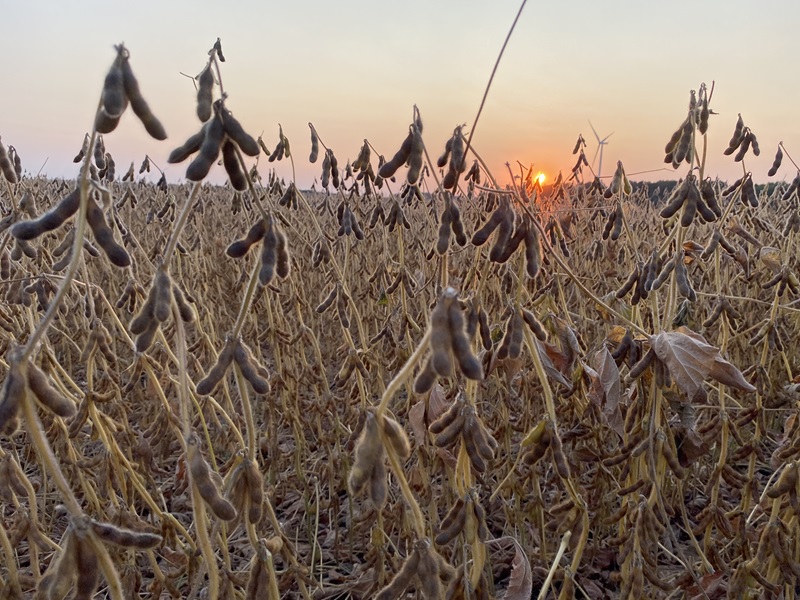
Soybean harvest is rapidly approaching, with field staging up to R8 (full maturity). R8 is reached when 95 per cent of the pods are mature in colour. Once R8 is reached, it can take five to 20 days of good drying weather to get the grain down to a harvestable moisture.
As harvest approaches and into the fall season, it is a great time to sample fields for soybean cyst nematode, specifically those that are having soybeans harvested from them, or those that will be planted to soybeans next spring. For more information on SCN and sampling, see this past Ontario Grain Farmer magazine article.
If considering pre-harvest management of soybeans, read this recent article from OMAFA on key items to consider and take into account as soybeans are maturing.
Frost damage on soybeans early in the fall, and with soybeans maturing in stages R6 to R8, is often limited, as early fall frosts are often lighter with less time spent below freezing. However, below freezing for too long can damage stems, pods and seeds. Typically, early-season frosts damage only the leaves in the upper canopy. Some maturity delays may be experienced on damaged plants, and pods near the top of the plant may abort or not fill.
There are still some areas that are short of moisture. A map showing the precipitation, departure from average can be found here (choose central, precipitation-departure from average and 60 Day Rolling in the options for an accurate representation of Ontario’s key growing period).
Cereals
Spring cereal harvest is 91 per cent complete by Wednesday, September 10, 2025. Maps showing harvest progress across the province can be found on the Grain Farmers of Ontario Field Progress page.
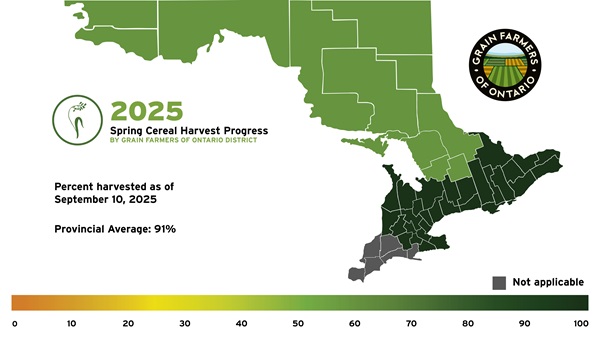
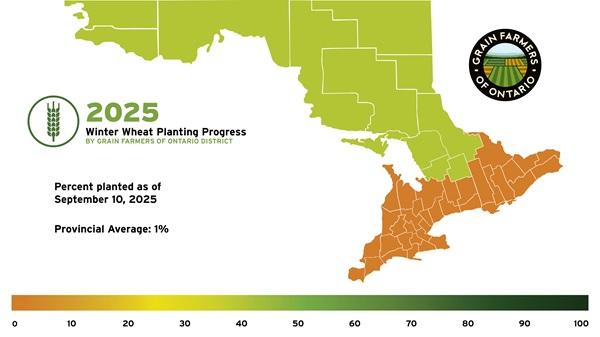
The 2025 Ontario Winter Wheat Performance Trials data are now available. The trials are conducted annually across Ontario through the Ontario Cereal Crop Committee, which Grain Farmers of Ontario is a member of.
Winter wheat planting has begun in northern areas and will begin in others in the coming days to weeks. The Optimum Planting Date for winter wheat map can be found here.
Planting into ideal conditions will help farmers maximize their yield potential. Be sure planters are set for the field conditions, check regularly – especially when starting a new field or when field conditions change. Ideal planting depth is 1” to 1.5” to ensure root development is in the ground and prevents easy spring heaving of seedlings when seeding is too shallow. Seed placed phosphorus (P) is well worth the investment. Having P in the row helps make more nutrients available at the seedling stage when the crop is establishing itself. Ensure that proper seeding rates are being used for early planting, optimum, or late planting. Aim for 1.6 million seeds per acre at the optimum date for each region. If planting before the optimum date, reduce rates by 100,000 seeds per acre per week. If planting past the optimum planting date, increase the rate by 100,000 seeds per acre per week.
September 4, 2025
The spring cereal harvest is 86 per cent complete across the province. Corn is nearing full dent, and some soybean fields are approaching maturity.
Corn
Corn is at or moving towards full dent (R5). Once corn has dented (on dent-type hybrids), the harder starch layer begins to form, and a distinct line of differentiation between the milky layer and the hardened starch layer becomes visible. This line of differentiation is called the milk line. This line will move further down the kernel as grain fill continues. Corn husks will start to senesce (turn brown) as the grain reaches maturity. Mature corn, which is corn that has reached black layer, can be expected in the next 3-4 weeks and is dependent on the heat (crop heat unit (CHU) accumulation) and stresses the corn plant is exposed to. Hotter dryer conditions will cause the plant to rapidly mature and result in shallower kernel fill (shorter kernels) and lower yields.
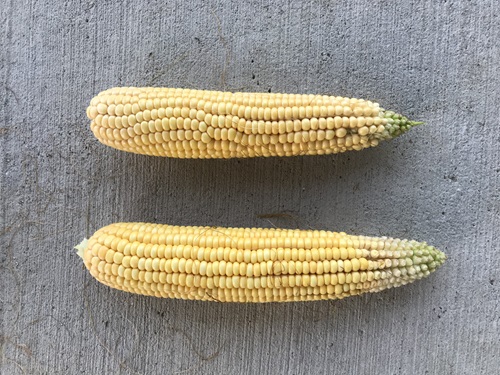
Some insect feeding is being found in corn. At fungicide timing, it is advised only to spray an insecticide if the insect threshold and insect stage of development are reached. This year, the timing of fungicide to control Gibberella ear rot and tar spot (should a fungicide be warranted) was sometimes ahead of when insect thresholds may have been reached. There may now be increased insect pressure in some areas, as earlier thresholds did not warrant a spray. Ear moulds are possible on corn that has had insect feeding, leading to Fusarium and then DON potential. Be sure to scout and identify fields that might have an increased risk of DON due to insect feeding.
As rainstorms have moved across the province, moving disease spores, Northern corn leaf blight, and tar spot might be found. More on tar spot can be found here. Many in areas prone to tar spot infection sprayed a fungicide, which will help protect the plant from disease, areas that did not may see infection, however since it is later in the season yield impact will be minimal.
Overall, the longer the corn plant’s leaves can be kept green, the better the grain fill in the kernels. This leads to deeper kernels and a better test weight, resulting in better yields.
Some might be seeing signs of nitrogen (N) deficiency. N deficiency in corn can be seen as a V shape yellowing on older leaves, as N translocates (N is a mobile nutrient) from the leaves (starting at the tip) and other vegetative tissues to the developing kernels, to accumulate dry matter and help complete grain fill. It is usual to see some N deficiency on corn leaves as the season extends, but too drastic a deficiency (deficiency symptoms extending to the ear leaf or whole plant yellowing) can certainly impact yield.
Potassium (K) deficiencies are also being identified. K deficiencies appear on the lower leaves first, as it is a mobile nutrient in the plant, and show up as yellowing to leaf death (necrosis) on the outer leaf margins, beginning at the leaf tip and moving towards the center of the leaf and down the leaf. Unlike N, K deficiencies begin on the outer edges of the leaf and should not be confused.
For both N and K deficiencies, rainfall helps mobilize the nutrients in the soil. However, if K deficiencies are being seen drastically or only in certain areas of the field some investigation should be done to better understand why the deficiency is occurring.
As yield estimates are ongoing across the province, for some areas, the thought is that the rains came a bit too late; cobs are showing poor pollination from stress during pollination, and others are showing aborted kernels after pollination due to moisture stress. Other areas are showing strong yields due to timely rains. Moisture can still help grain fill during this time.
As harvest approaches, especially in areas that have experienced a lack of moisture or other in-season concerns, stalk integrity will be important to monitor. More can be found in the stalk integrity factsheet.
Soybeans
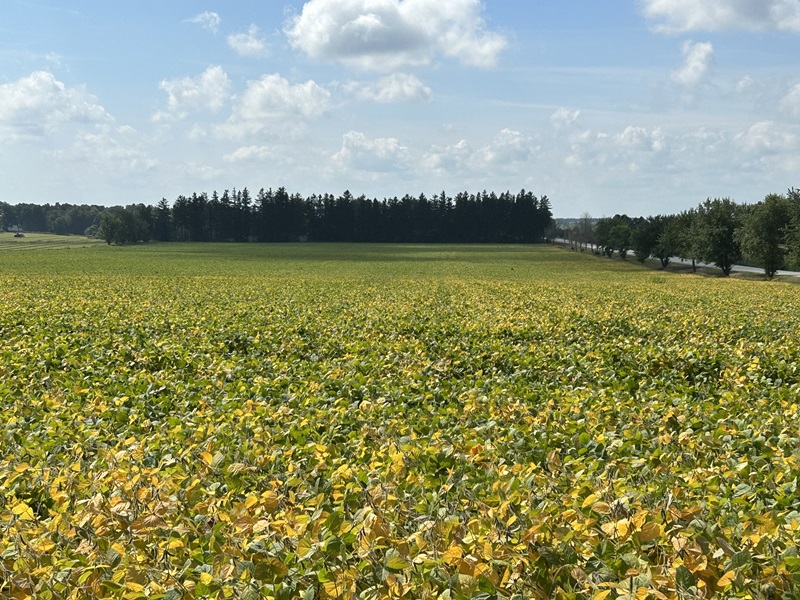
Soybeans are in some areas turning yellow with leaf drop occurring, with other fields it will be occurring in the coming days to weeks as fields reach the maturity (R7) stage. As fall approaches and a change in weather patterns is experienced, late-August to early-September showers, when they transpire, will be very valuable for soybean fill, for those soybeans that are still maturing. As shared in the past Grain Farmers of Ontario webinar: Dry weather issues and updates, until the soybean plant has reached full maturity and the seed disconnects from the pod, the grain is still able to be filled.
Uneven field maturity that was noticed over the past few weeks is an indication that not everything is uniform in the field. Low spots could be greener due to less stress from more moisture available during the growing season or they could be delayed spring emergence due to not enough moisture at planting, leading to delayed plant development.
Areas of fields that are turning yellow quicker than other areas need to be investigated, as it may be an indication of disease or insect pressure. Possible concerns include soybean cyst nematode (SCN) populations in the soil, spider mites or late season root rots (however root rots this year will be minimal). Moisture deficits due to spring compaction may be an issue to look for, and of course, areas that have experienced extreme dryness will see corresponding impacts. Scouting never stops, and finding out the cause of the problem as soon as it is seen is important. Trying to diagnose leaf, stem, or root issues will be difficult at harvest. Proper identification of problems will lead to better management of the field in future years.
Fields that have not started to mature are most likely double-crop soybeans planted in July, in which case they will be maturing in October. Timely rains on the still-growing fields will continue to keep the double-crop soybeans growing and putting on seed weight and yield.
Palmer amaranth is a weed that has the potential to emerge in Ontario. Keep a close watch for weeds that have emerged mid-season, and be sure to identify what they are in order to manage for next season (more on management in last week’s e-news).
Wheat
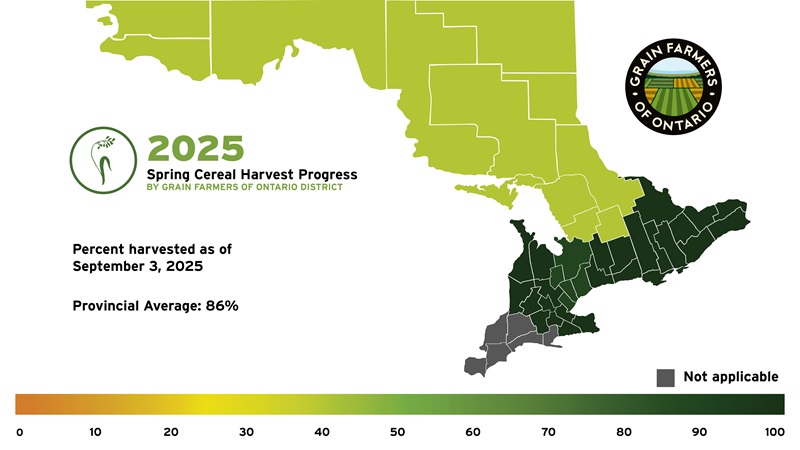
Spring cereal harvest is 86 per cent complete as of September 3, 2025. Maps showing harvest progress across the province can be found on the Grain Farmers of Ontario Field Progress page.
As winter wheat planting approaches, consider the following key points:
- Earlier planted wheat, planted into good conditions and with ideal weather, will tiller more in the fall, making a larger, denser canopy
- Denser canopies with heavy snow loads can be the right conditions for snow mould
- Early established stands of winter wheat with ideal conditions will attract insects
- Cereal aphids are one concern, as they vector Barley Yellow Dwarf Virus. Aphids are present in the fall, and are more likely in early-planted fields, as these fields have emerged when adults are present, and allow their offspring to prosper for the following spring.
- Seed selection for the area of planting. View GoCrops.ca for variety trials across the province.
- Choose the right seed treatment for the situation.
If planting early, reduce the seeds per acre as fall tillering will be inevitable. Check the seed size of the seed being planted (on the bag tag) and adjust the planting rate to hit the targeted population. Early planting is considered two weeks before the optimum planting date. Be sure to make changes when planting earlier than optimum. Optimum winter wheat planting dates for Ontario can be found here. The rewards for slightly early to optimum planting can be great if the crop is managed correctly through all stages.
Other topics to consider for the season, including fall weed control, starter fertilizer, seed selection and more, are covered in this past Ontario Grain Farmer article.
As the season continues, scout wheat fields as plants develop and start to assess the crop for possible adjustments in the crop management plan. Nitrogen application rate and timing in the spring need to be based on the needs and demands of the crop. Use a fungicide application to control disease pressure under dense canopies.
August 28, 2025
As August comes to a close, so does much of the cereal harvest, with just a few hundred acres left to be harvested for the winter wheat harvest, and the spring cereal harvest is 75 per cent complete across the province. Corn and soybeans are moving through the reproductive stages.
Corn
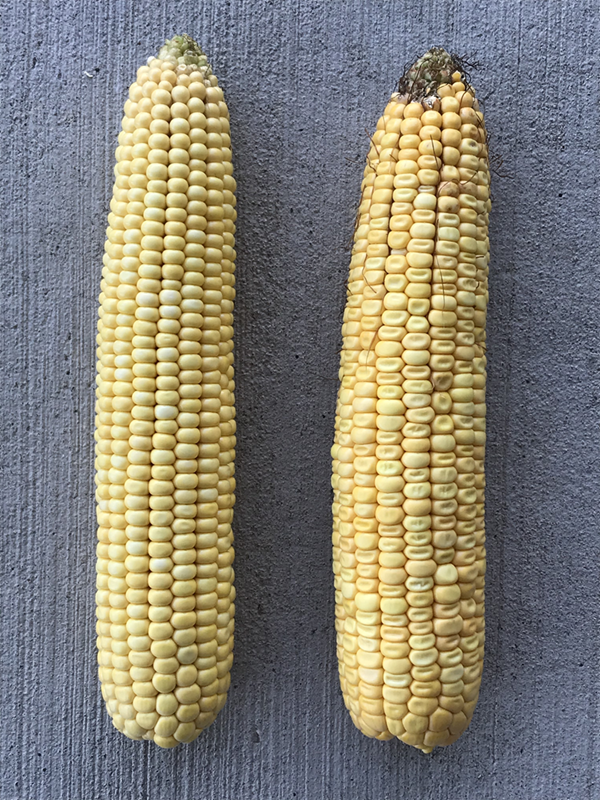
Corn is now starting to form a visible milk line as it hits the R5 (dent) stage, while many other later pollinated hybrids are in the R4 (dough) to early dent stage this week. September will see a rapid movement of the milk line as the corn plant approaches R6 (physiological maturity – black layer) in the next few weeks. Currently, this is the critical grain fill period for the corn crop when the plant focuses all its energy on filling the kernel. The depth and weight of the kernel will be determined over roughly the next three weeks. Maximum sunlight (solar radiation) and adequate rainfall (moisture) will provide the crop the best opportunity to fill the kernels with starch. As harvest approaches, pay particular attention to corn stages. With a lack of moisture, some areas are showing variation in maturity within the field and within the cob.
The milk line of the corn kernel is the line on the kernel where the hard starch meets the milky wet part of the immature kernel. The milk line will continue to progress to the tip of the kernel as the corn produces more starch and packs it into the kernel. Once the milk line has reached the kernel tip (sugars converted to starch), then the kernel is full and the black layer is formed, which restricts the transfer of starch.
There are still several areas showing indications of a lack of rainfall from average; more can be seen here (choose central, precipitation-departure from average and 60 Day Rolling in the options for an accurate representation of Ontario’s key growing period). For insights on how a lack of moisture impacts crops, Agricorp programs, and mental health resources, view the recent Grain Farmers of Ontario webinar: Dry weather issues and updates. Also, OMAFA has shared information on evaluating and salvaging moisture-stressed corn for corn silage here and utilizing moisture-stressed corn as feed here.
Soybeans
Some soybeans are turning yellow (it always seems so early!). There are several potential reasons for this observation; early-season soybeans may be reaching this stage in their reproductive growth. Additionally, patches in fields may exhibit some early maturing soybeans, not due to the maturity level, but rather because of compaction at planting time, ponding during the growing season, or a lack of moisture. These soybeans are shutting down early due to a lack of root development in some cases and overall, due to the limited available soil moisture in the root zone. Stages for soybeans across the province range from R5 (beginning seed) to R7 (beginning maturity).
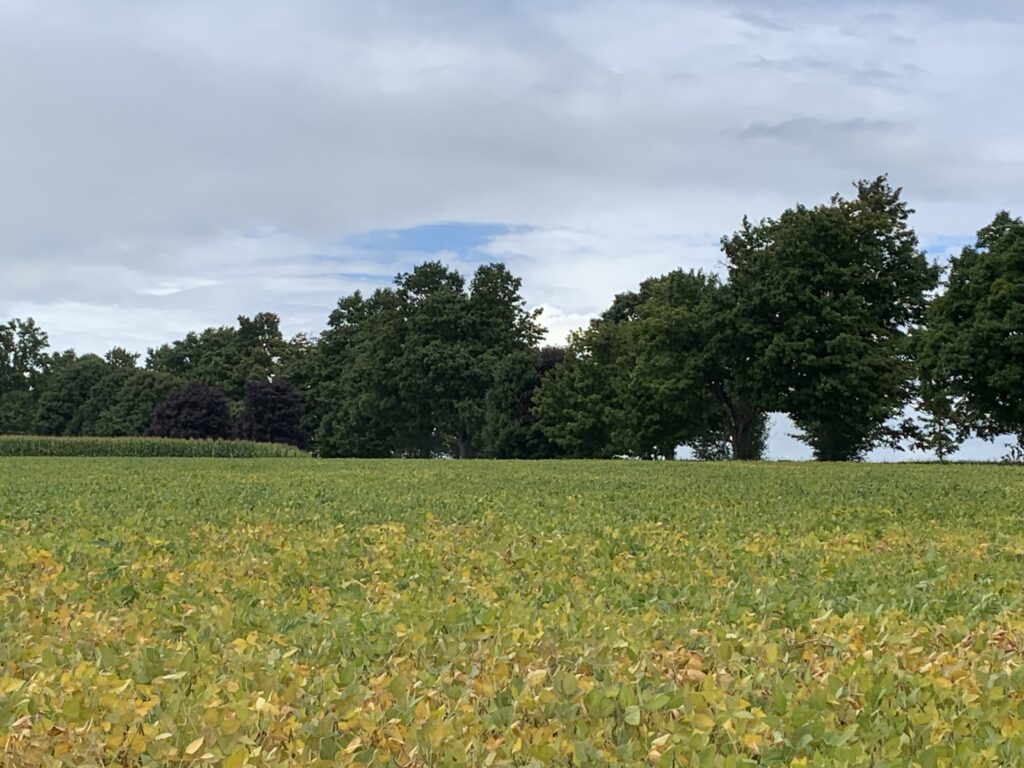
For the soybeans that are edging closer to maturity, in some areas, the pods don’t seem as full as they could be, with a limited number of pods on the lower part of the plant. Over the growing season, there has been vegetative growth; however, when assessing development in the field, it is noted that some of the lower branches aren’t podded, unlike in other years. As drier and hotter weather has moved in, more of the smaller pods have been dropped from the plant, as the plant’s main goal is to fill the current pods, so excess pods will be lost during periods of stress rather than continuing seed formation. Not all is lost, as having limited pods and seed will mean that as timely rains arrive, the plant will continue to fill the remaining seeds and the seed size could be larger.
Still be on the lookout for disease. Sudden death syndrome (SDS) seems to be popping up more in fields that may not have seen it before. Characteristics of SDS are random plants dying throughout the field. If you dig up the plant and split the stem, the pith (middle of the stem) will be white, while the roots may be rotten. More info can be found in past e-news articles.
Spider mites are still causing some challenges, more on them in past e-news articles. Pay attention to pre-harvest intervals if management is required, and always read and follow the product label.
Scout for weeds, including waterhemp and fleabane, are proving to be somewhat challenging this year in some areas.
Waterhemp has resistance to multiple herbicide groups, and it can emerge throughout the season. At this point in the season, identification is key, unfortunately, at this point, management is challenging due to the stage of the grain crop and size of the weeds.
Next year, implementing a 2-pass herbicide program that has multiple effective modes of action with good residual activity will be key for these and other problematic weeds.
In the short term reduce the spread of this weed by properly identifying and isolating the contaminated fields by restricting equipment movement and ensuring that equipment has been thoroughly cleaned, prior to moving to clean fields. After harvest, plant a cover crop, such as oats, cereal rye, or an oat/ oilseed radish blend. Cover crops will inhibit waterhemp emergence, growth, and seed production. Mowing or clipping may be necessary to minimize seed production of escaped plants.
Should there be any weed concerns out of the ordinary please contact Mike Cowbrough (mike.cowbrough@ontario.ca, 519-820-2336, OMAFA).
Other sources of information on tough to control weeds can be found on Ontario Crop IPM, a source for information on crop pests, disease and weeds, for information specific to waterhemp visit here. Manage Resistance Now shares several factsheets and videos on weed resistance and how to manage tough to control weeds.
As soybean harvest approaches, learn more about drone seeding a cover crop into soybeans in this OSCIA Living Lab project. Grain Farmers of Ontario supports Living Lab Ontario.
Cereals
Spring cereals are currently being harvested, with 75 per cent harvested as of Wednesday, August 27, 2025. Rains over the past week have slowed down harvest, but I don’t think many are complaining about the rain delay this year.
Winter wheat harvest is wrapping up, with northern Ontario on the final stretch for winter wheat, with just a few hundred acres to go.
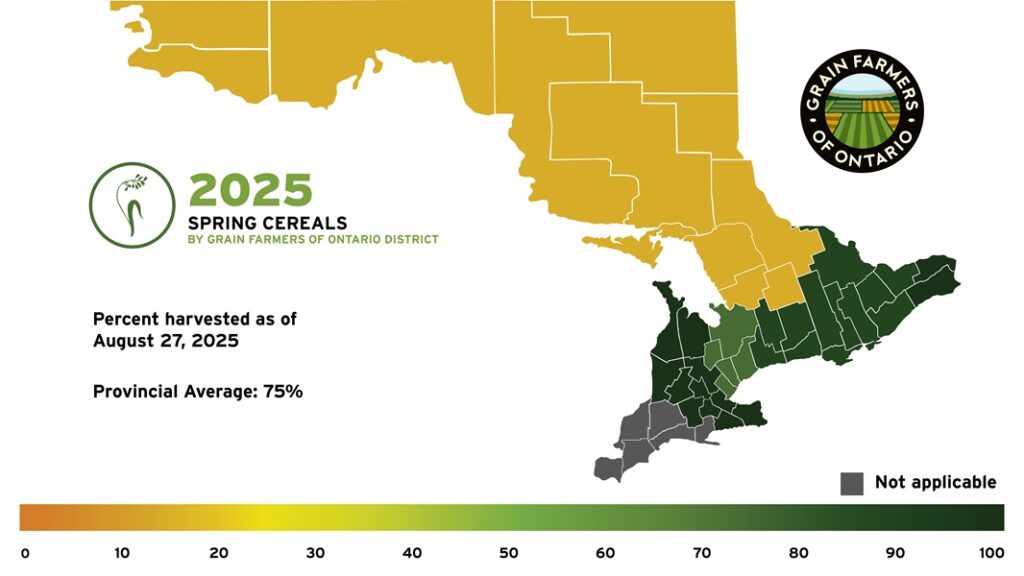
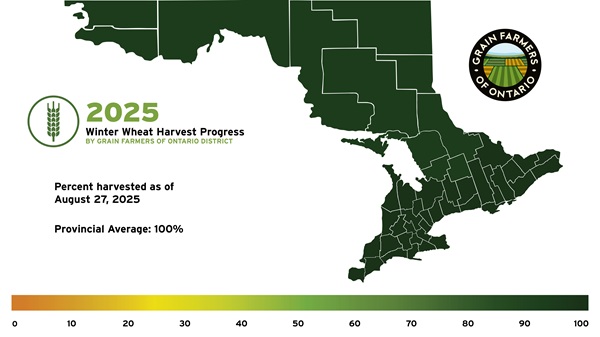
It will soon be time to plant winter wheat. If using your own seed or receiving certified seed, be sure to check seed counts.
Handling treated seed- things to remember when handling treated seed
Grain contamination can result in load rejection at the elevator. Common grain contaminants include treated seed, fertilizer, animal feed, and other foreign materials. One of the leading causes of harvested grain contamination is using equipment that previously handled treated seed or other contaminants without proper cleaning before harvesting grain. To learn more about how to prevent grain contamination, please refer to the Grain Farmers of Ontario factsheet.
Mental Health
If you are struggling this season and need someone to talk with, there are support resources geared to farmers, available 24/7.
August 21, 2025
Some welcome rains fell across much of the province over the past week; however, more precipitation would still be appreciated in many areas. The winter wheat harvest is 99 per cent complete, and the spring cereal harvest is 61 per cent as of August 20, 2025. Keep scouting for insects and disease in both the corn and soybean crops.
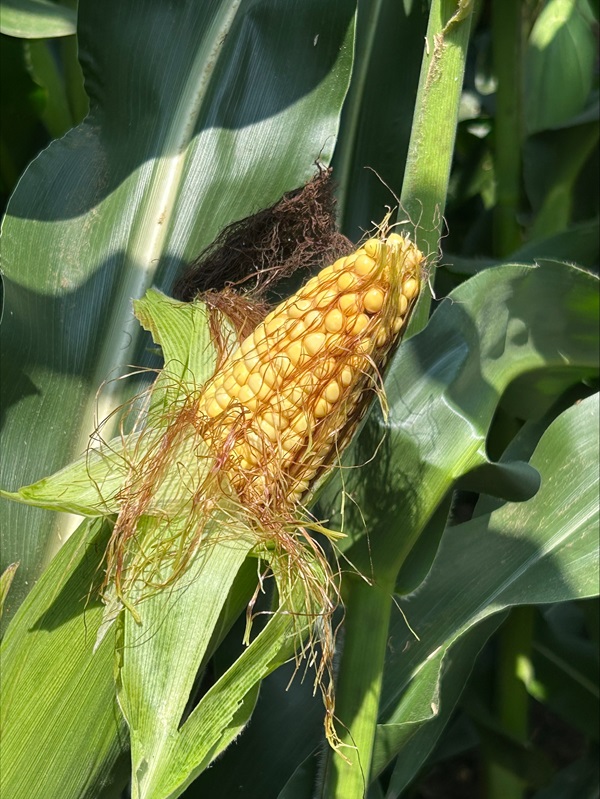
Corn
Corn can now be seen staging up to the R4 (dough) stage this week. R4 is roughly 24 to 26 days after silking. The kernel’s milky fluid will now be changing to a doughy consistency. Near the end of R4, some kernels will start to show denting as the plant is just a few days from the R5 (dent) stage. There is no milk line showing yet, so corn is not officially at R5. In the coming days, the milk line will appear as it has been about 30 days since pollination. In another 30 to 35 days, the kernels will black layer, which is when the crop is physiologically mature and will be safe from any frost threat.
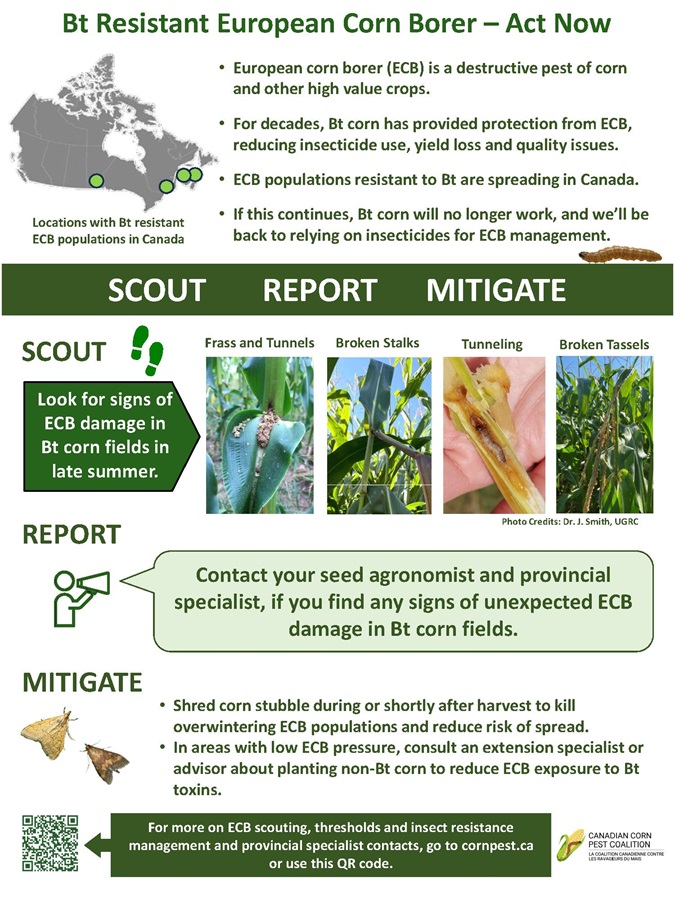
Plants still in the R3 stage can see kernel abortion due to severe stress, but not as easily as the R2 stage. Overall, the tip kernels are the first to be aborted as they are the last to be fertilized and have less vigour. At the early R4 stage, kernel abortion is less likely to occur; however, severe stress at this point of the season can affect yield by reducing kernel weight.
Keep an eye out for tar spot; recent moisture and temperatures are conducive to its development.
Soybeans
Soybean pod clusters are present. Fields are staging up to the R5 (beginning seed) to R6 (full seed) stage as the pods near the top of the plant are filling out. As the plant reaches this maturity point, flowers will be harder to find, as the plant now focuses on filling the pods. Sunlight and good moisture conditions over the next few weeks will help size up the soybeans and help keep the plants from aborting too many pods. Areas that have had a lack of moisture will be experiencing fewer beans per pod (0 to 3 beans), as a sign of stress, and some areas with a lack of moisture and/or lighter soils have seen plants begin to yellow and die. There are uneven fields across the countryside.
Scouting should still be occurring. Target identifying soybean diseases as control and prevention is no longer an option. Identification can help with understanding what disease is robbing the yield and potential changes that can be implemented in future years. In past e-news articles, soybean cyst nematode and sudden death syndrome in particular have been highlighted. Be sure to scout and take notes of fields and varieties that are showing symptoms, using this information to make informed decisions for future planting.
Also, watch for weed escapes. Are the weeds in your field still needing to be dealt with? If growing IP soybeans, it is imperative to keep volunteer corn out of the harvested grain, along with staining from nightshade. Be sure to have a plan as harvest approaches. If the thought is that there may be some resistant weeds, take note and make plans for future herbicide applications.
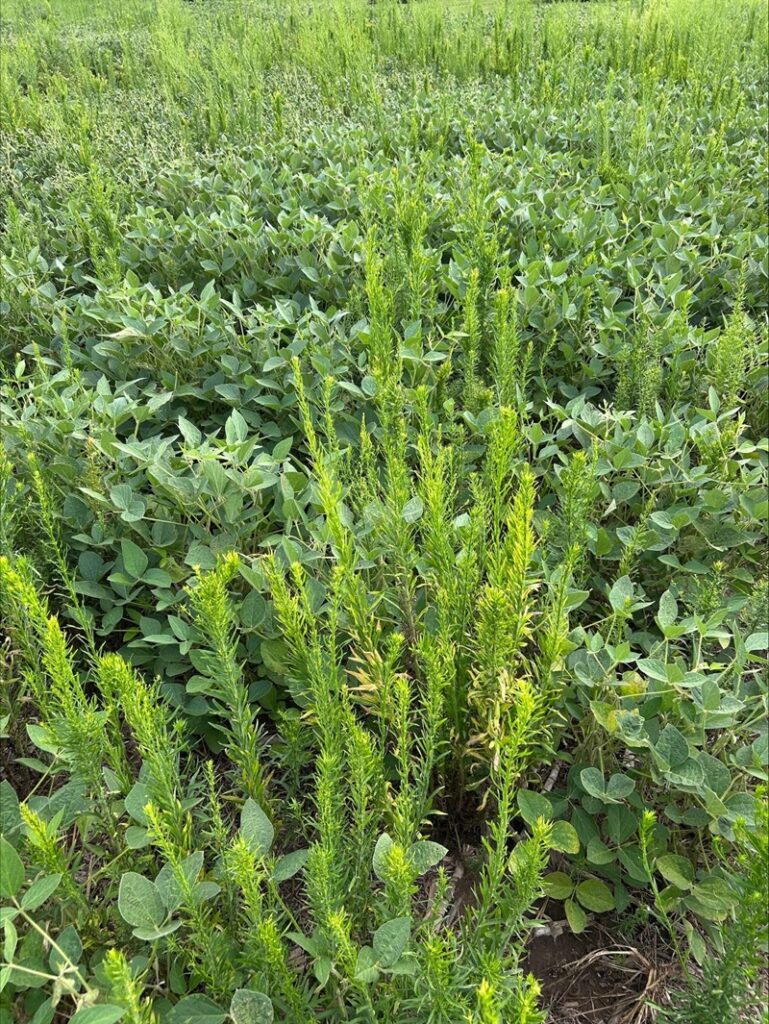
Spider mites are showing up in fields, as they often do in hot, dry conditions. While there are drought conditions, be aware that sometimes infestations are misidentified as drought stress – be sure to walk fields and look. Mites move in from the edge of the field, being blown by the wind. More information can be found in this Field Crop News article from last year.
There certainly is variability across the province, with most areas experiencing some amount of moisture deficit. Areas that have not received enough rain and/or that are on lighter soils are showing signs of stress. Crop stages will also be impacted by a lack of moisture, either in delayed stages or by plants drying down. A map showing the precipitation, departure from average can be found here (choose central, precipitation-departure from average and 60 Day Rolling in the options for an accurate representation of Ontario’s key growing period).
View the recent Grain Farmers of Ontario Dry Weather Conditions Webinar.
In this webinar:
- Gain insights on how Agricorp’s business risk management programs can help
- Hear from OMAFA crop specialists on crop management options, including considerations of salvaging dry-weather-damaged crops for livestock feed, and the process to take water for crops and livestock
- Learn more about mental health resources
Cereals
Explore Field Progress from Grain Farmers of Ontario. This page provides weekly updates on planting and harvest progress across the province, broken down by Grain Farmers of Ontario’s Districts 1-15. Currently, it features the latest insights into winter wheat harvest progress and spring cereal harvest progress across Ontario. As the year progresses, Field Progress will also highlight soybean and corn harvest, along with winter wheat planting progress.
This week, Field Progress shows winter wheat harvest being 99 per cent complete, as of August 20, 2025.
Spring cereal harvest is at 61 per cent complete as of August 20, 2025.
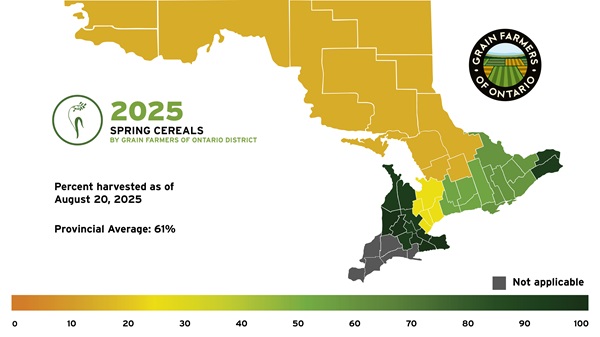
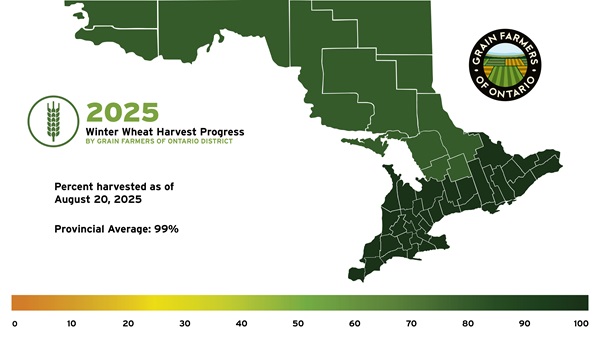
The Ontario Cereal Crop Committee (OCCC) conducts variety performance trials of cereal varieties in the province of Ontario. Results of the 2025 winter wheat trials will be available in the coming weeks at GoCrops.ca under the ‘Performance trial results’ heading. Grain Farmers of Ontario supports these trials across the province.
August 14, 2025
The winter wheat harvest is now 99 per cent complete across the province. Meanwhile, corn and soybean crops continue to progress through reproductive stages. Recent rainfall has provided relief in some areas, though others remain challenged by dry conditions. Regular scouting is still required for various insects, as some areas are seeing increased pressures.
Corn
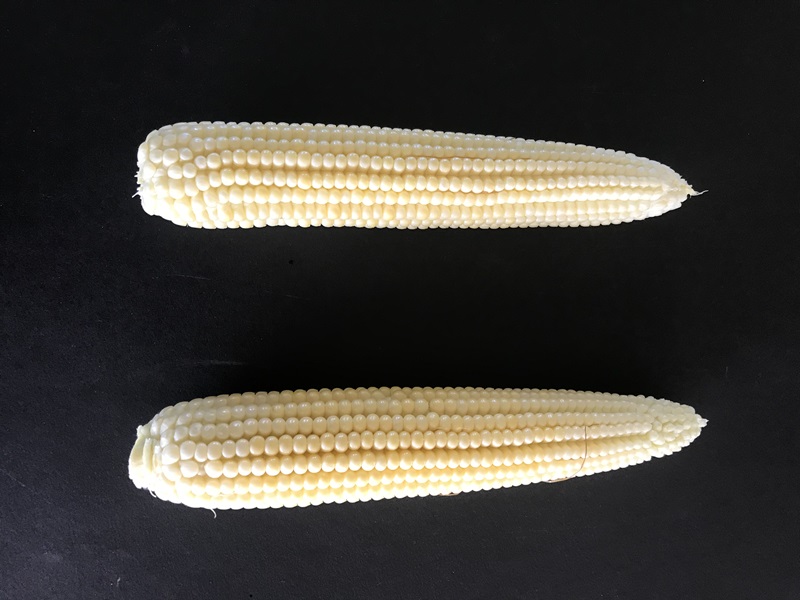
Corn is now in the R2 (blister) to R3 (milk) stage which is a great time to evaluate pollination. Peel back some husks and see how the ovules are developing. Some areas to assess are how many missed kernels there may be and where they are on the cob. The bottom of the cob is the first to be pollinated; as those silks emerge first, they will be the first ovules to be fertilized and may be more developed than the others near the tip. If you notice that the tip of the cob has no ovules developing and green silks are still attached and there is no pollen left on the tassels, this signals that pollen was no longer viable by the time the tip silks emerged from the husk. If there are pollinated kernels missing at the bottom of the cob, that would signal that potentially the silks emerged well before the pollen began to shed and became too long for the pollen to effectively travel down the silk to pollinate the ovule (damaged silk tubes etc). Sporadically missed kernel pollination on the cob could be independent challenges of that specific silk channel as the transporting of the pollen grain to the ovule was impeded. If one side of the cob is not pollinated, typically referred to as zipper cob, this can be caused by severe drought, severe defoliation, or severe nutrient deficiency problems around pollination time.
In the areas that have experienced drought stress on their crops prior to receiving some timely rains, the plant stature is shorter, and the bottom internodes are abnormally short on the lower half of the plant with larger internodes above the cob. This would indicate stress at the V5 to V8 stage, and better growing conditions afterwards. Ear husks tend to be short on plants that have been stressed due to drought, with many ears with exposed tips. Drought conditions shorten the husk development, and later rains allow for ear length to extend longer than normal. The exposed tips are detrimental, as insects and birds will eat the tips, and could allow for an infection point for ear moulds.
Areas that have experienced drought conditions without relief will be experiencing shortened crops, poor pollination and leaf firing among other challenging topics.
There is a webinar that is taking place on Thursday, August 14 to discuss the management options for crops experiencing dry weather. More info below.
Grain Farmers of Ontario Webinar: Dry Weather Issues and Updates
Thursday, August 14, 2025 7:00 PM EST
- Gain insights how Agricorp Business Risk Management Programs can help
- Hear from OMAFA crop specialists on crop management options, including considerations of salvaging dry-weather-damaged crops for livestock feed, and the process to take water for crops and livestock
- Learn more about mental health resources
Now a great time to get out scouting for Corn rootworm. Fields that have continuous corn, repeated use of the same rootworm BT traits, and fields that had high corn rootworm populations in previous years are high priority fields, as BT resistance may be found. CRW can clip roots, limiting nutrient and water uptake and can clip silks which can have an impact on pollination. Get out and look for these insects – ideally now, but certainly before early September. For what to look for specifically visit Field Crop News or read over our Agronomy Alert.
Soybeans
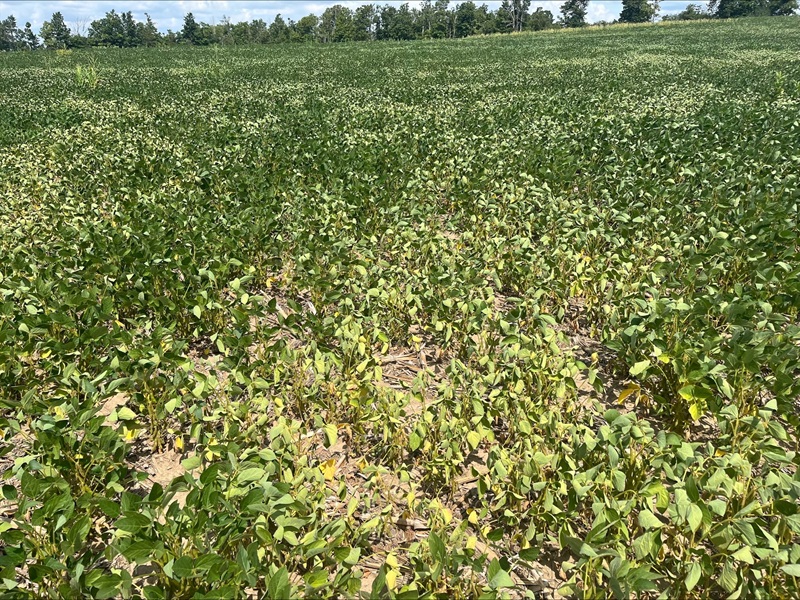
season and lack of rainfall during key crop development stages.
Through August, soybeans will require timely rains to help the development of the soybean seed and prevent drop in the seed count per plant. With many fields in the R4 (full pod) to R5 (beginning seed) stage extreme heat like some areas of the province experienced this past week can be detrimental to soybeans as the heat causes stress. Stress can encourage the plant to abort the top pods, along with any new pods forming. If moisture levels do remain where they are for the regions that have received rain more flowers are being developed on the plant, and full yield potential has not been realized yet. With adequate soil moisture this month, seed count and sizing should be good. However, for areas that were already needing moisture, and did not receive recent rainfall, pods will be aborted.
Insects are still being found in soybeans; aphids are being found at economic threshold to warrant a spray in some areas (particularly eastern Ontario), as are spider mites are also being identified. More info on aphid thresholds and management here. More on spider mite identification and thresholds can be found here. Also scout for stink bugs, tarnished plant bugs and bean leaf beetles, scouting and thresholds available here.
Soybean Cyst Nematode (SCN) may be showing up in some areas. The impact is not always obvious in fields that are looking great, or those that have had ample moisture. But in poorer fields, and fields that have lacked moisture you may notice stunting, slow canopy closure, and chlorotic foliage in patches. Find out more here.
Cereals
Winter wheat harvest is 99 per cent complete as of August 13, 2025. For information on overall wheat quality visit Grain Farmers of Ontario Wheat Quality Survey.
Spring cereal harvest is 32 per cent complete as of August 13, 2025.
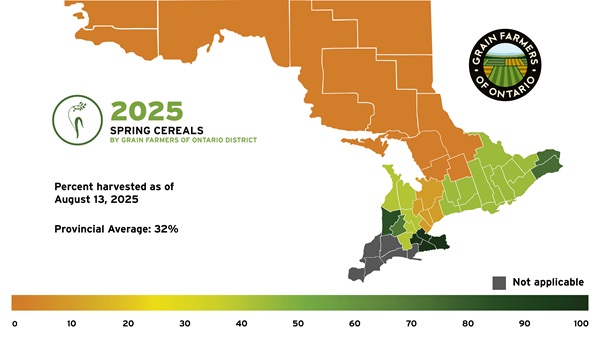
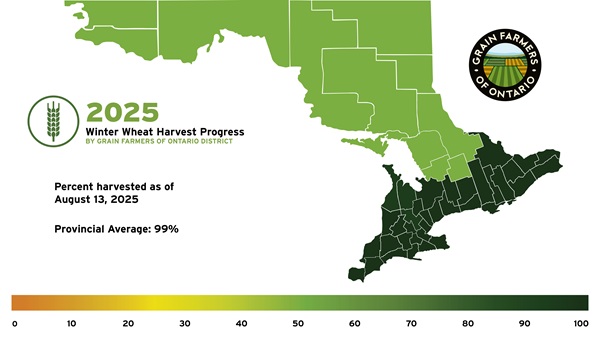
There are still several areas showing indications of a lack of rainfall from average, more can be seen here (choose central, precipitation-departure from average and 60 Day Rolling in the options for an accurate representation of Ontario’s key growing period).
With dry conditions in some regions, fire risk to equipment and fields is elevated. Be sure to oil and grease bearings and other moving parts. Hot belts and exhaust from tractors, combines and balers, along with sparks from metal hitting rocks and other friction points can cause a spark that may easily start a fire.
OMAFA recently shared an article for future considerations on Maximizing rainfall capture through soil management.
Mental Health
If you are struggling this season and need someone to talk with there are support resources geared to farmers.
August 7, 2025
Rain is a good thing, but many areas are experiencing a lack of rain this season. The corn and soybean crops are well into reproductive stages. Winter wheat harvest has had an incredible stretch of good harvest weather and is 93 per cent complete provincewide.
Corn
With corn pollination nearing an end across much of the province, corn is in the late R1 (silking) to R2 (blister) stage. With the R2 stage, it is time to do some pollination checks. Once dry silks appear at the tip end as brown silk, a quick husk of the cob and a shake of the cob can reveal the potential kernel count. There have been reports of pollination issues in some areas, so getting out to scout is key. Knowing the potential is good, but drought stress, nutrient loss, disease, and insect feeding can still cause kernels to be lost in the upcoming weeks. It is always a great idea to keep track of weather patterns and temperature throughout the crop’s growth. It is interesting and sometimes valuable to look back and be able to target when certain stresses occurred; fewer rows on the cob could be from stress around the V6 to V8 stage when the cob is forming, and stress around the V8 to V12 stage can affect the kernel number per row. Kernel potential is set by V12 but is highly impacted at pollination and grain fill. Hence, the potential of 900 ovels (18 x 50) on an ear at pollination can end up only being a 630 kernel cob (18 x 35) at harvest.
Western bean cutworm (WBC) trap counts are climbing. The ideal time for control is over the peak flight timing. Finding egg masses in drought-stressed corn can be challenging because leaves are curled up, making it harder to see the shadows of the masses. Take time to scout.
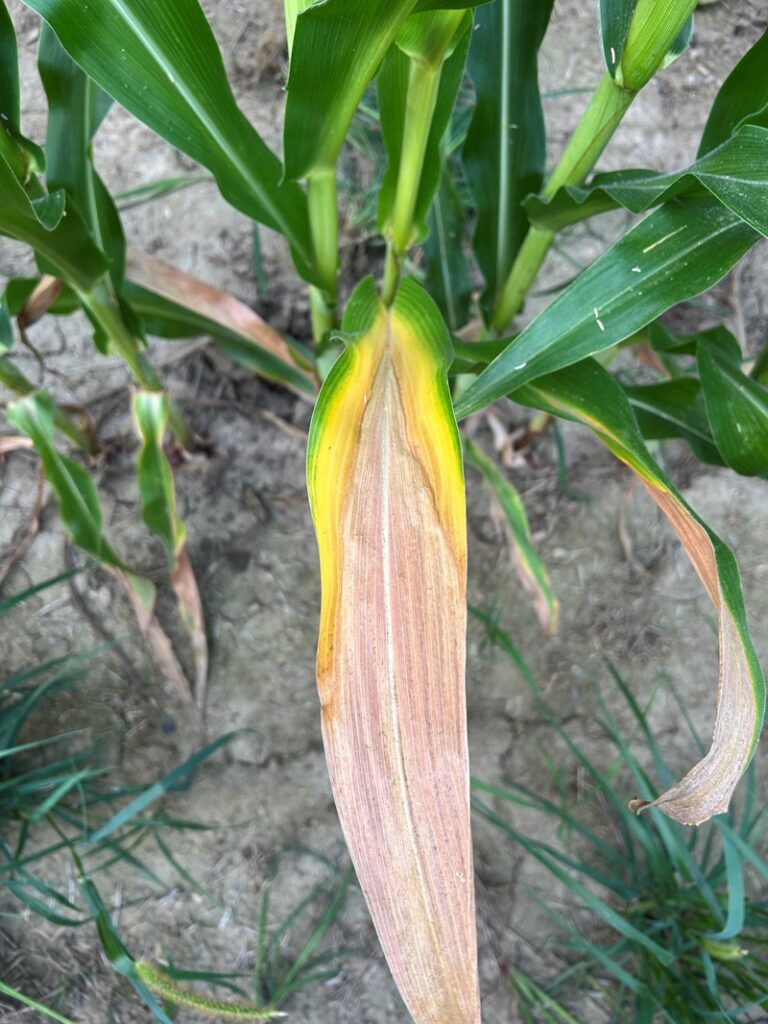
Smoky skies have been seen over much of the province due to wildfires. Heavy wildfire smoke was also seen in 2023. Smoke can act like cloud cover with respect to solar radiation by reducing the amount of sunlight/solar radiation that plants are able to intercept. When solar radiation levels are impacted by smoke, C4 (fix carbon using C4 photosynthesis process) plants, such as corn, can be impacted greater than C3 plants, such as soybeans and wheat. In some cases, the smoke can help diffuse light, which can be beneficial for photosynthesis, but the overall decrease in solar radiation would most likely outweigh the benefit. Overall, however, the answer on how smoke impacts crops is a bit “hazy”. More can be found in this 2019 study and this article.
Nitrogen (N) is an essential plant nutrient for determining grain yield. The plant takes up N through its active growth, with approximately 35 percent of N taken up from VT (tassel) to R3 (milk). Some corn might be showing signs of a N deficiency. N deficiency in corn can be seen as a sphere-like yellowing on older leaves, as N translocates (N is a mobile nutrient) from the leaves and other vegetative tissues to the developing kernels, to accumulate dry matter. It is usual to see some N deficiency on corn leaves as the season extends, but too drastic a deficiency (deficiency symptoms extending to the ear or whole plant yellowing) can certainly impact yield. Areas that are lacking rain will most likely see N deficiency symptoms earlier, as soil moisture plays a critical role in the movement of nutrients to the plant roots. Plants that are showing significant N deficiency should be monitored for stalk strength as the season progresses.
Soybeans
Soybeans are in the R4 (full pod, ¾” long at one of the four uppermost nodes) to the beginning of R5 (beginning seed, seed 1/8” long in a pod at one of the four top nodes on the main stem) across much of the province. In areas where drought stress has not aborted pods or flowers, pods are forming in nice clusters, which should lead to good yields. In areas where there is stress, plants will have aborted or will be aborting flowers and pods, which, of course, will affect final yield. Some regions have experienced low rainfall since early June. As of early August, there are several areas showing indications of a lack of rainfall from average, more can be seen here (choose central, precipitation-departure from average and growing season in the options for an accurate representation of Ontario). The timing of rainfall, if rain was to be had, is crucial. Some areas had early rain in the season, but as critical crop growth stages approached, there was a lack of rain (June/July), causing severe crop stress, especially with added heat. With less rainfall, lighter ground and knolls of hills could be showing signs of plant death due to a lack of moisture.
Now is the time when white mould symptoms often show up. At this point, most soybean fields are past the timing for fungicide applications for white mould or for late-season disease. Plants that are affected by white mould will die, affecting yield. For future years, the fungus survives in the soil for years after infection of the plant as sclerotia. No variety is completely resistant, but some are moderately resistant. Early planting, narrow row widths, and high plant populations allow for early canopy closure and support the disease. So, in future years, keep this in mind. Crop rotation can also help; two to three years of a non-host crop can help reduce the pathogen in the soil.
Other leaf diseases, such as powdery mildew, are still showing up in canopies. Sudden death syndrome and Soybean cyst nematode are also diseases to be on the lookout for. Both can severely impact yield.
Cereals
Winter wheat harvest is nearing completion across the province, as of Wednesday, August 6, 2025, 93 per cent of the harvest is complete.
Spring cereal harvest is at 10 per cent, as of August 6, 2025.
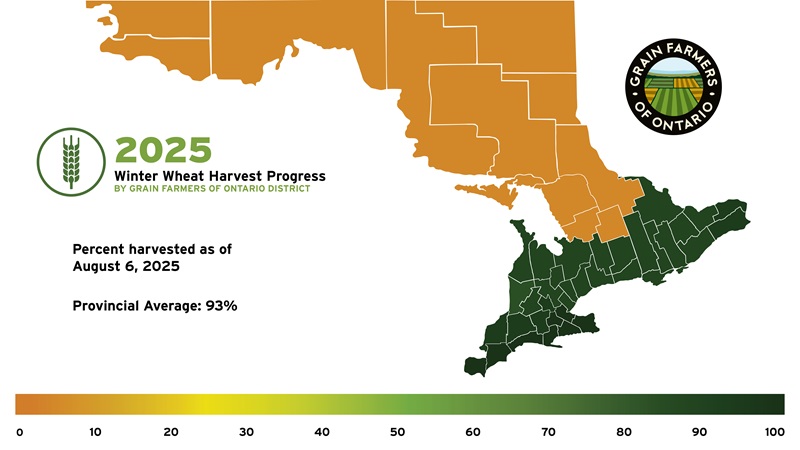
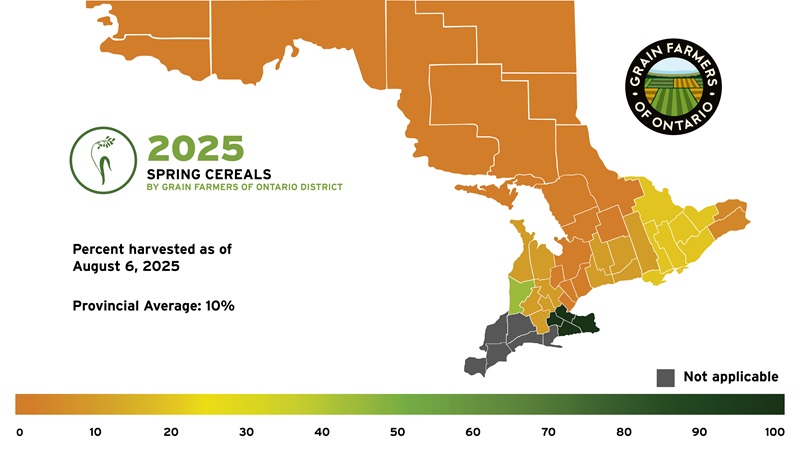
With winter wheat harvest getting closer to completion, it is time to look towards the fall when winter wheat will be planted. Selecting the variety of wheat to plant is a very important decision. A good variety selection allows for the opportunity for high yields. Ideally, choose a high-yielding variety that has good disease and lodging resistance. As harvest wraps up, the 2025 winter wheat performance report will be posted later in August at GoCrops.ca. Grain Farmers of Ontario supports the Ontario Cereal Crop Committee trials.
After the wheat harvest is a great time to soil sample fields for nutrient content, and soil sampling falls under good 4R nutrient management. View our webinar on 4Rs and soil sampling here and our factsheet on 4Rs here.
For information on cover crop recommendations, the Midwest Cover Crop Council has a Cover Crop Decision Tool that has Ontario recommendations built into it. The tool was partly funded by Grain Farmers of Ontario.
If you are struggling with mental health due to drought, harvest concerns, or other issues, please speak with someone. Resources geared towards farmers are available here.
July 31, 2025
As July wraps up and we head into August, there is still lots to scout for in fields—pests and disease unfortunately don’t take summer holidays. Corn and soybeans are in reproductive stages, and winter wheat harvest is progressing, with 69 per cent complete, while spring cereal harvest is just beginning.
Corn
Most of the corn is in the VT (tassel) to R2 (blister) stages.
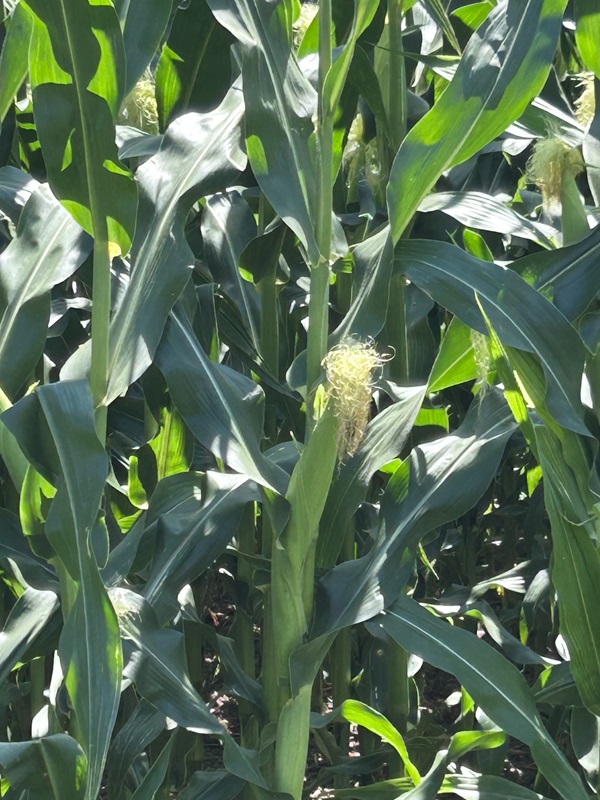
Corn has been getting sprayed with a fungicide, as needed, the past few weeks as farmers look to suppress Gibberella ear rot and Fusarium ear rot (ideal timing for fungicide is at fresh silks), along with tar spot (ideal timing R1) and other leaf diseases. Learn more about Gibberella ear rot, DON, and Tar spot. Areas that experienced or are experiencing drier and hotter weather during pollination should see a reduction in the infection risk for Gibberella, as temperatures were in excess of the ideal 27-26 oC.
Grain Farmers of Ontario supports an annual DON survey, through the Ontario Corn Committee, which takes place in late September. The survey will give a good indication of hot spots for DON accumulation throughout the province, should there be any.
Quite often around this timeframe, Western bean cutworm traps have shown an increase in catches, scout for eggs and act as required. For more information on WBC counts, control, thresholds and more, read here. Insecticide applications should be timed to meet peak flight at the R1 (silking) to R2 (blister stage, where kernels look like blisters with clear liquid). Insecticides can often, and should, be tank mixed with a fungicide to control later-season diseases. If a fungicide has already been sprayed, be sure to follow the label instructions and limit the amount of a particular class of fungicide and switch groups to manage disease resistance.
Scouting for corn rootworm concerns should be occurring, particularly on corn-on-corn fields. More on this pest here.
Shortly after the silks are dry is a great time to scout how pollination went. There has been some discussion on some corn pollination issues (in Ontario and south of the border). In some cases, as in Ontario, the tassel was shedding pollen, but the silks were not yet present. Delayed silking can be caused by several factors; severe drought stress can delay silk emergence, high temperatures can speed up the pollen shed process narrowing the window of pollen shed, insect feeding can also impact silk growth, and environmental stresses (heat and cold causing slowed or rapid growth) can also cause pollination challenges like the tassel wrap issues across the corn belt. Genetics can also come into play with plant characteristics. It is important to note that tassel development occurred around V6, so what might have occurred a few weeks ago environmentally or otherwise could now be impacting pollination today.
When scouting, visit multiple locations in the field, take note of silks (were insects feeding on them, length of silk etc.), inspect ears by removing the husk, are there parts of the ear that are not pollinated, are kernels in very different stages on the ear, any other observations help diagnose what might be occurring. Overall, take note of which hybrids and fields have concerns and follow up on ear development to harvest. Understanding possible concerns early will help diagnose problems and avoid them in the future. Selecting a diverse hybrid portfolio with different characteristics can help manage challenges that might arise over the season.
Soybeans
Soybeans in general look good, but there is a range this year from too wet fields to too dry. Most soybeans are in the R3 (beginning pod, 3/16” pod on the four uppermost nodes on the main stem) stage to R4 (pod 3/4” long on one of the four uppermost nodes on the main stem).
White mould could start showing up in soybeans around now. White mould is caused by the pathogen Sclerotinia sclerotiorum. Fields with dense canopies that have experienced rain, fog, and dew during the flowering stage may see higher rates of white mould infection. Fields that have been infected with white mould in the past are certainly more prone to infection as the black sclerotia (looks like mouse droppings) overwinter in the soil and produce fungal spores when the temperature and moisture are right for infection. Symptoms from white mould can be seen after flowering by looking into the canopy and looking for the white mycelium on the stem. In the upcoming weeks, dead plants will be observed in fields. Heavy rains during the reproductive stages can favour symptom development. Soybean cyst nematode (SCN) and soil compaction can increase the incidence of the disease, with SCN symptoms often showing up around now. More on white mould can be read here.
Fungicide applications for white mould can be made in soybeans, ideally around R1 to R1.5, just before full flower and pod set. Fungicide applications made around the R3 stage are for protecting plants against late-season disease.
Sudden death syndrome (SDS) can be seen in some fields and should be scouted and monitored for. SDS can be mistaken for other diseases. Pay particular attention to field experience SDS for future management options or partially resistant varieties, rotating crops and minimizing soil movement from field to field. SCN populations have been associated with SDS and may increase disease severity, so also work on managing SCN.
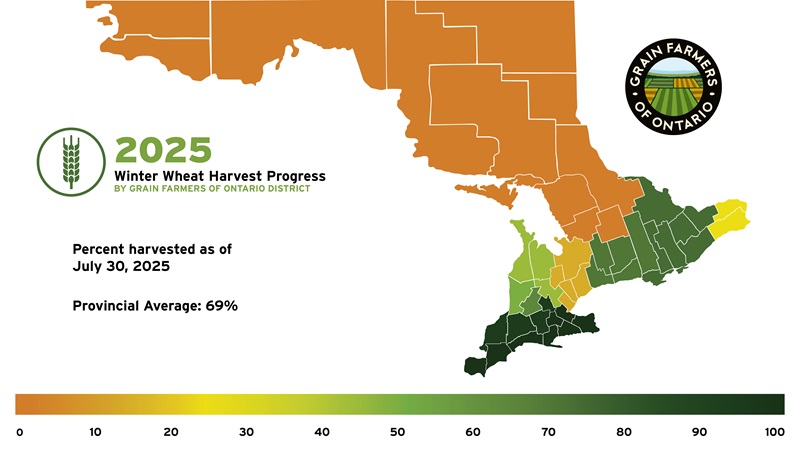
Cereals
Winter wheat harvest is now 69 per cent complete province-wide, as of Wednesday, July 30, 2025. Some regions have experienced wet weather after grain maturity in the field- wheat should be harvested as quickly as possible to maintain quality in these areas.
Oats, spring barley and spring wheat have seen harvest commence, with 2 percent harvested by Wednesday, July 30. There are still fields ripening across Ontario, with harvest approaching in the next couple of weeks for those regions. Be on the lookout for armyworm, and act as warranted, paying attention to pre-harvest intervals.
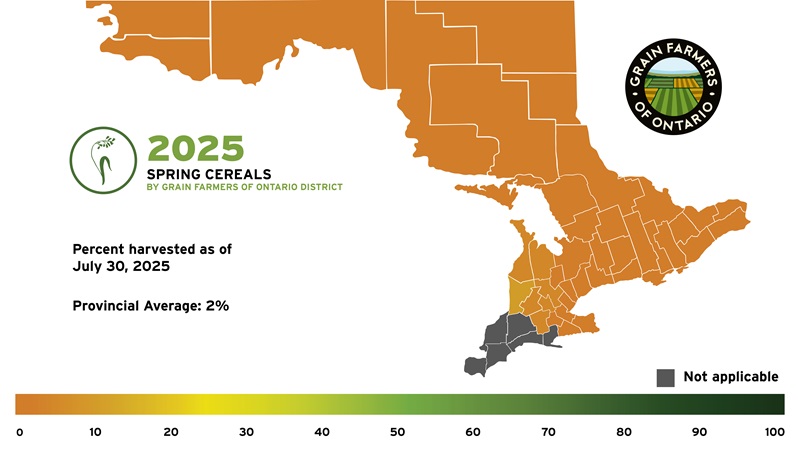
If considering a cover crop this year, check out the Midwest Cover Crop Selector Tool that uses Ontario research data to suggest the best cover crops for your operation.
Crop Protection Network Crop Risk Tool
The crop risk tool provides weather-based forecasting and risk assessments for various crop diseases (including Tar spot, Northern corn leaf blight, Gibberella ear rot, white mould and frog eye leaf spot), helping farmers to make data-driven decisions. The tool allows users to select the crop and location, planting date and more to create a risk assessment. Grain Farmers of Ontario supports the Crop Protection Network.
July 24, 2025
The winter wheat harvest is 36 per cent complete across the province, corn is tasseling, and soybeans are flowering. There is certainly a lot going on in Ontario’s grain fields.
Corn
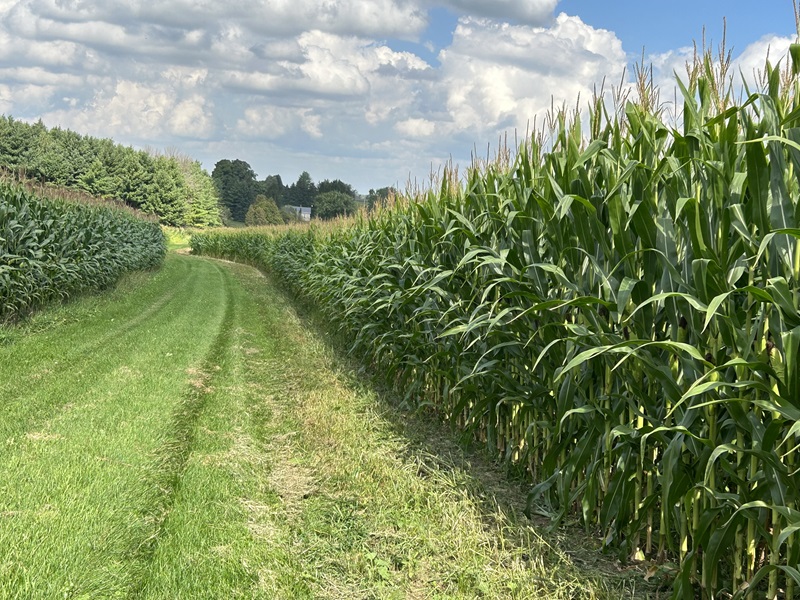
Corn is tasseling now across some of the province (VT stage), and if not tasseling, it will be in the coming days. When a plant is dissected, and the inner leaves are unfurled, if there are 3 to 4 more leaves before tassel emergence, the plant will need 150 to 200 growing degree days (GDD). The plant requires 50 GGD per leaf, so plants with 3 to 4 more leaves will need approximately 10 more days before tassel emergence.
Tar spot has been detected in Ontario. An easy way to identify tar spot is that it looks like tar and does not come off if wetted and rubbed. If it is found on the lower leaves, the infection is coming from previous years, as the pathogen is in past plant matter. If it is found on the newer leaves, it is a new infection in the field. No-till, corn-on-corn, and wet conditions with high humidity all increase the risk of tar spot. The crop risk tool provides weather-based forecasting and risk assessments for various crop diseases (including tar spot and northern corn leaf blight), helping farmers to make data-driven decisions. The tool enables users to select the crop, location, planting date, and other factors to create a risk assessment.

If more warm, humid conditions occur this summer, other leaf diseases like northern corn leaf blight (NCLB), grey leaf spot (GLS), and eyespot may also appear. A major ear disease infection to watch out for is Gibberella ear rot, caused by the Fusarium infection during the silking period, which can produce the DON toxin in corn. When controlling corn diseases with fungicides, be sure to know which diseases are being targeted and select the correct fungicide. The Crop Protection Hub is a great resource to find crop protection options for Ontario. Learn more about other diseases and more in the past GrainTalk webinar on pests and diseases to watch for.
Western bean cutworm trap counts and scouting are occurring. More info on scouting and management options for this pest can be found here.
European corn borer scouting should also be taking place.
Soybeans
Soybeans in general are looking good this year, but there is certainly a range across the province where areas that have been too wet or too dry are identifiable. Plants are in the R2 (full bloom) to R3 (beginning pod) stage. It is not uncommon around this time to find developing pods, flower buds, open flowers, and dying flowers all on one plant. Yield increases most generally come from increased pod counts per plant, particularly large yield increases. Stress, such as high temperatures or moisture limitations, can cause reduced yields. As a plant matures from flowering to beginning seed, the ability of the plant to compensate for stress decreases.
Farmers are or might soon be applying fungicides, if applicable, to help manage disease and potentially increase crop yield. Many fungicide applications are to help control white mould, which can affect the yield of soybeans. Certain varieties are more prone to infection, as are fields that were planted early, have a narrow row width, and have high plant populations.
Aphid populations have warranted spray in some situations across the province; continue scouting for these pests.
Grain Farmers of Ontario supported the development of the Pest Manager app, in collaboration with the Ontario Ministry of Agriculture, Food and Agribusiness (OMAFA), which enables you to identify, map, and find integrated management options for common weeds, insects, and diseases in corn, soybeans, and cereal crops. Any pesticide use information in the app is specific to Ontario only. Users should always read the product label before use.
Be aware of off-target movement of herbicides. Learn more about how to prevent drift and what to do if it is suspected here. More information on drift can also be found at BeDriftAware.ca.
Double-crop soybeans have been planted after winter cereal harvests in the southwest region of the province. Emergence will be determined by water availability for the seed to imbibe water, germinate and emerge.
Cereals
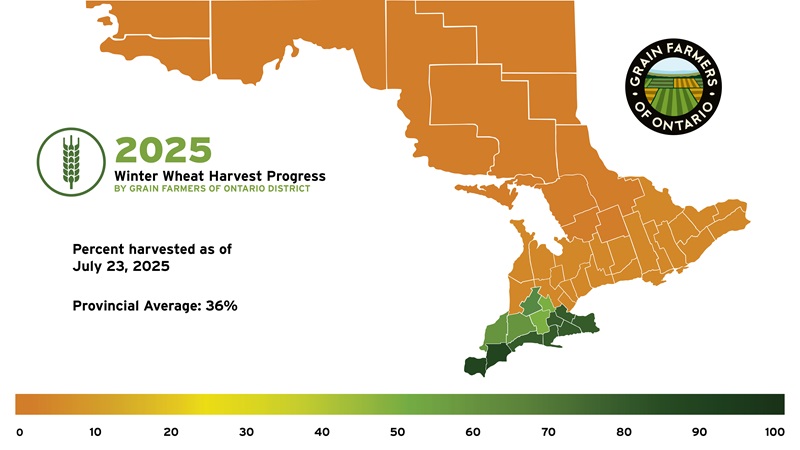
According to Grain Farmers of Ontario Field Progress, the winter wheat harvest is 36 per cent complete province-wide as of Wednesday, July 23. Some rain over the weekend slowed down harvest. However, during my travels over the weekend, I noticed some fields being harvested with green-looking straw, so perhaps a couple of days’ delay isn’t too terrible and will help the crop thresh better. With recent rains, be on the lookout for sprouts and prioritize harvesting those fields first, as wet weather after grain maturity can result in sprouts, which can lead to one of the causes of lower falling numbers.
Oats and barley are in the grain fill period in southern Ontario, with harvest commencing in the next few weeks.
If considering a cover crop this year, check out the Midwest Cover Crop Selector Tool , which uses Ontario research data to suggest the best cover crop management for your operation.
Harvest can be a busy, stressful time. If you need someone to talk to, there are resources available.
July 17, 2025
The winter wheat harvest continues. Corn is progressing into the reproductive stages while soybeans are beginning to see some pods. Be prepared to manage disease in both corn and soybeans as required.
Corn
Corn is staging at V10 to tassel (VT). As corn enters the tassel stage, there are some interesting points to note. Ideally, tassel emergence with silks starting to show is best. As the tassel emerges, the pollen starts to shed. In areas that have received little rain (such as some regions of central Ontario), silk emergence may be delayed as the plant conserves as much moisture as possible. In certain dire situations, silking may not occur or last very long due to severe drought. If the tassel has emerged with most of the pollen shed occurring before silk emergence, poor pollination may occur, resulting in a poor kernel set on the ear.
Each silk that emerges is connected to a potential kernel within the husk. When one silk has emerged from the corn husk across 50 per cent of the field, the R1 stage has begun. Complete silk emergence can take four to eight days once the first silk appears. If the silk is pollinated, the silk stops growing; if it is not pollinated, the silk will continue growing for up to 10 days.
As corn is pollinating, thoughts turn to Gibberella ear rot and the potential for DON accumulation. Ideal temperatures for Gibberella infection are in the 27 °C to 28 °C range, accompanied by continuous wetness from rain or high humidity, during the pollination period. For hybrids that are susceptible to DON, or if favourable conditions are present, a fungicide application may be advisable. Further DON production will also be determined by the environmental weather conditions received during grain fill. More information on DON in corn can be found here. The 2024 Ontario corn hybrid DON screening trial report can be found here. The report communicates multi-year data that shares a relative risk assessment of corn hybrids and can be used as another tool in the toolbox
There are a few products currently labelled to suppress Gibberella and Fusarium ear rots, the diseases that are the precursors to the DON toxin. Be sure to choose a product with multiple active ingredients to control said diseases. Available products that are registered are available on the OMAFA Crop Protection Hub, always read and follow the label paying particular attention to the ideal application timing of R1-fresh silks. If applying for gibberella/fusarium management please also consider good leaf disease suppression in the product applied, as leaf disease can also be a large yield robber.
Should the plan be to apply a fungicide, be sure to let your agronomist know, as the application window and sprayers used for application can be limited. Albert Tenuta, field crop plant pathologist with OMAFA has worked on trials that look at sprayer systems and nozzle configurations by evaluating both spray coverage and a chemical tracer at the silks, the initial results were highlighted in an article in Ontario Grain Farmer, with further information here from Sprayers101.
Tar spot has been identified in Chatham-Kent, Elgin, and Haldimand-Norfolk counties for the 2025 season, which is not entirely unexpected. More on Tar spot can be found here. Be prepared to take action with a fungicide; the Ontario Crop Protection Hub is a great resource for crop protection options.
It’s time to scout for Western bean cutworm (WBC) as adults are being found in traps and egg masses are being found on leaves. The western bean cutworm factsheet, Scouting and Management in Field Corn, states, “when there is an accumulation of five per cent of the plants scouted with fresh egg masses or small larvae over a two to three week scouting period, threshold has been reached. For example, if during the first scouting trip two per cent (two out of 100) of the plants have egg masses on them, then five days later during the second scouting trip, there were three per cent (three out of 100) of the plants with fresh egg masses, then threshold has been reached.”
Management of WBC should wait until peak flight, which, according to the OMAFA trap networks, is yet to come. WBC larvae can feed on the corn cob, affecting yield. Feeding can also increase the risk of DON mycotoxin development, which is a serious concern.
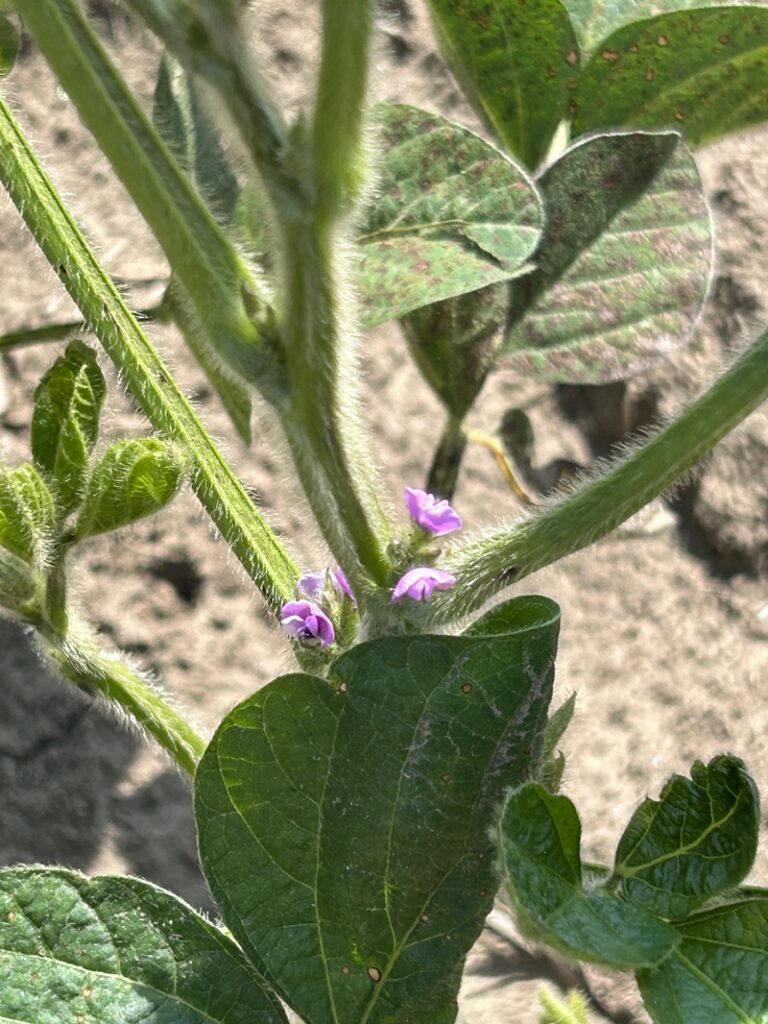
Soybeans
Many fields have reached the R2 (full bloom) to R3 (beginning pod) stage. This disease can be a concern in areas that have had ample amounts of moisture and/or high fertility, as canopies are very lush. Also, the wet, humid days that some have experienced have created the perfect environment for diseases such as white mould. The Crop Decision Tool, supported by Grain Farmers of Ontario and powered by the Crop Protection Network, can assist with making management decisions for white mould in soybeans.
Keep an eye out for aphids in soybeans. Look here for more information on threshold levels and when to spray.
Overall, there are various diseases and pests to be on the lookout for this summer. Learn more about hot topics this summer in this past GrainTalk webinar.
Cereals
Winter barley harvest is in progress, as is winter wheat harvest.
Provincial winter wheat harvest is at 11 percent, according to Field Progress, with moistures ranging from 14 to 18 per cent. Some fields are being harvested at slightly higher moistures and being dried to limit the chance of lodging or sprouts occurring. It is always a good idea to take a sample into the elevator if there are any questions around quality. Discuss with the potential receiving elevator(s) what options are available if the sample does receive a downgrade.
Ensure that the combine is set properly to manage residue, especially if not baling straw. Proper residue management with uniform distribution of the straw is key.
Review the primary grade determinants table for Eastern Soft Red Wheat.
After wheat harvest is a great time to soil sample fields for nutrient content. Soil sampling falls under good 4R nutrient management. View the GrainTalk webinar on 4Rs.
After cereal harvest is one of the ideal times to seed cover crops into the field. The Cover Crop Decision Tool is an invaluable resource that utilizes Ontario-based research to inform the best cover crop options tailored to the region of Ontario and specific goals.
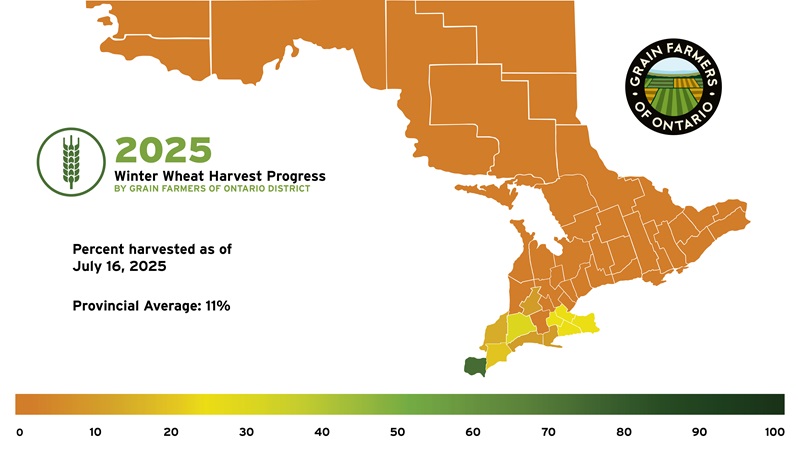
Field Progress
Explore the newly launched Field Progress from Grain Farmers of Ontario. This page provides weekly updates on planting and harvest progress across the province, broken down by district. Currently, it features the latest insights into winter wheat harvest progress across Ontario. As the year progresses Field Progress will also highlight spring cereal, soybean and corn harvest progress.
Grain Farmers of Ontario research
Recently, the Ontario Soil Network hosted a research day, where research that is funded by Grain Farmers of Ontario was highlighted. Topics included N inhibitors, strip till along with lysimeter studies, long-term rotation trials and long-term rotation trials integrating cover crops into the rotation. Some key learnings shared include;
- Integrating winter wheat into a rotation helps boost other crop yields.
- Nitrification inhibitors can be a tool in the toolbox to help lower ammonia volatilization, with more research being completed to be able to provide site specific tangible information that will narrow in on the how and in what combination is the best to reduce losses while maintaining farm profitability.
- When looking at different cropping systems, lysimeters are helping to look at how global warming affects soils and how that in turn impacts yields.
- Fields that incorporate cover crops can see a reduction in nitrate leaching by up to 70 per cent (depending on the mix), with most losses being seen in the spring, along with freeze/that cycles.
A special thank you to all the presenters and their advising professors for helping make this research come to life!
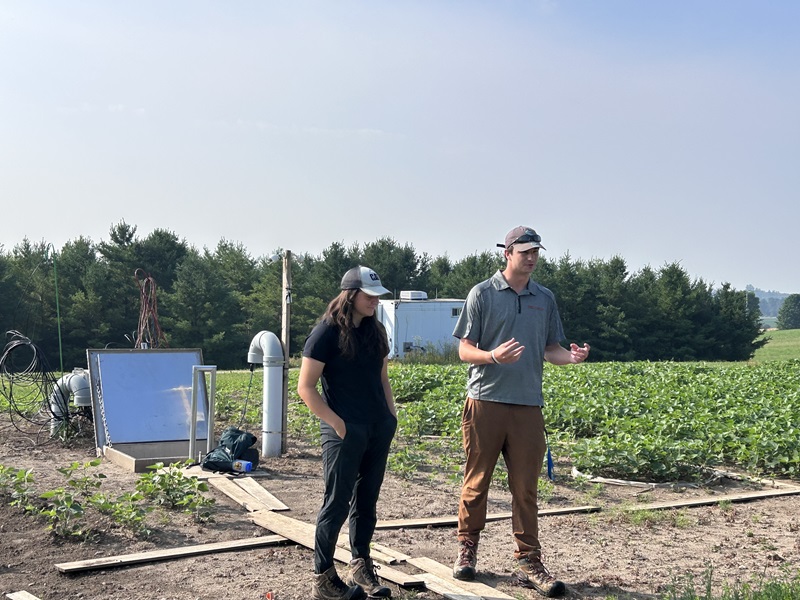
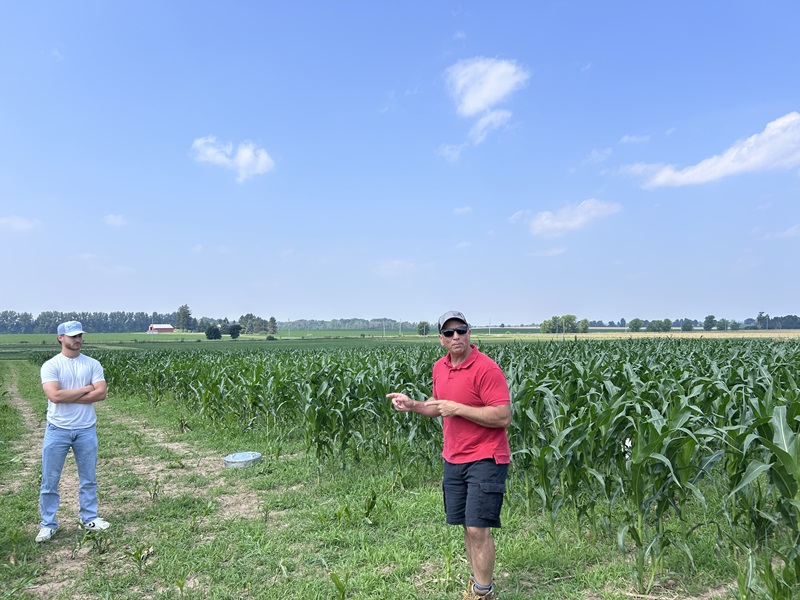
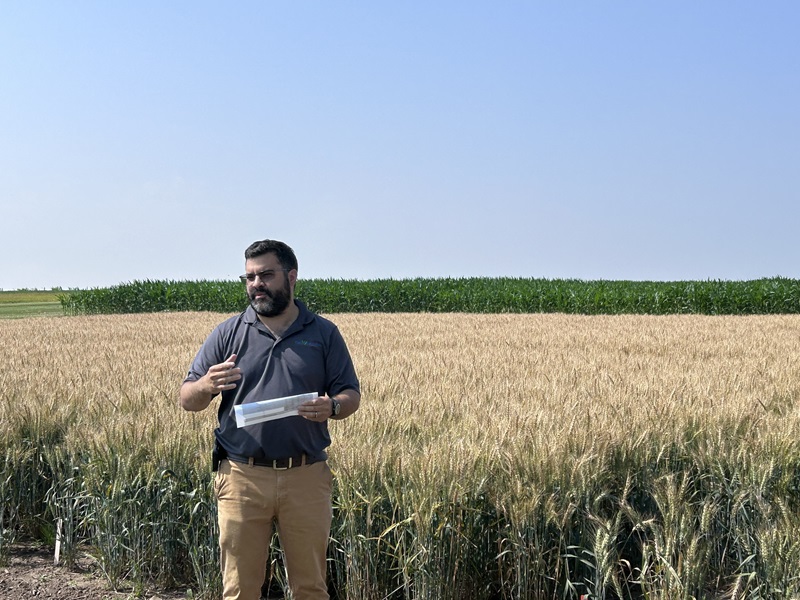
July 10, 2025
Winter wheat harvest has begun! Soybeans are flowering, and corn is developing its ear. Scouting should be taking place for disease and insects across the province.
Corn
Corn growth has accelerated over the past couple of weeks with higher-than-average temperatures. Corn is staging V10 to V12. Tassels will emerge within the next two weeks for the early-planted corn. Some areas have seen a lack of rain and are receiving higher temperatures, causing several extended days of heat stress. Corn is showing this stress with leaf roll. The rolling of the leaves is to prevent excessive moisture loss through evapotranspiration. This natural defence is thought to protect the plant by reducing water loss, but is most likely just a reaction of the plant when the water loss is greater than the water it can replace by its roots. Bottom line, this indicates the excessive stress is causing the corn to have a bad day. As ear development is occurring now, an impact on kernel number and ear size will occur. You will notice different parts of the field showing stress, which can be related to soil or plant conditions that are limiting water uptake of the plant, such as compaction or other soil physical characteristics like water holding capacity or lack of a good root system.
As tassels emerge, silks will also emerge shortly after. Silks should emerge a little ahead of pollen shed this year, where there is ample moisture. In drought areas, it may be common for silks to emerge just after tasseling as the plant is conserving moisture under stress. However, with the upcoming weather forecast, most regions should not be in a water-limited situation. Silk emerges and will keep growing until the pollen grains have made their way down the silk channel to the ovule, at which time pollination occurs, and the silks will be terminated and dry up. The best fungicide application timing to prevent fusarium infection and DON production later in the season is when the silks are viable and fresh.
Pollen shed from tassels can occur over several days. Pollen shedding is dependent on the environment and the genetics of the corn hybrid. Some plants will shed a little each day for three to five days, while other plants (later plants) with smaller tassels may shed quickly in fewer days as they may be under more environmental stress (hotter temperatures, limited water availability and competition).
While it might be thought that cool, moist conditions for pollination and grain fill are good, those same conditions that prolong silk and pollen viability also are the ideal conditions for Gibberella ear rot and lead to DON mycotoxin production. Find out more here.
Many different ear disease infections can occur at silking time, as silking is the time when the ear is exposed to pathogens such as Fusarium and Gibberella. Depending on weather conditions and the spores in each field, ear disease development begins at the pollination stage. Infections can also occur from other ear damage from insects, animals, or hail. Which ear disease takes hold will be dependent on what spores are in the field and what weather conditions are ideal for those spores during and after infection. It is all about timing.
Corn, in general, is looking good, and it is important to keep the potential for high yields high. Fungicides may be applied for plant health and/or for ear health. For the most susceptible situations, farmers will look to protect their ears with a fungicide application at silking time, in an attempt to keep DON levels low. If weather patterns look threatening, or if a highly susceptible variety is being grown, it will be more likely for an application to be made. Refer to the label instructions for the best application time to help reduce infection risks. GoCrops.ca has the 2024 Ontario Corn Hybrid DON Screening Trials report. Use this report as a tool in the toolbox as a relative risk assessment for the hybrids that are being grown.
Along with the heat of the summer comes scouting for corn rootworm. The ideal timing to scout for damage in corn is July until early August. Find out what fields to target first for scouting, what to look for, and what to do if you see damage in this factsheet, also in this GrainTalk webinar.
Soybeans
Early-planted soybeans are staging from late vegetative stages to the R2 (full bloom) to even R3 (beginning pod) stage. The R3 stage is when there is a pod formed that is at least 3/16 inch long (but less than 3/4 inch long) at one of the four uppermost nodes on the main stem with a fully developed leaf. R3 can last anywhere from five to 15 days and is also when flowering peaks. Flowering overall usually lasts about 3 to 4+ weeks.
With the heat and moisture, white mould may be forming in some areas. The dead flowers that fall off the plant are an infection point, allowing mould to grow, and that mould moves into the plant. Those who applied a fungicide might see fewer incidences. Be sure to be on the look out for it in fields. More info can be found here. Those with a history of white mould and those with high fertility, dense canopies should pay particular attention.
As shared a couple of weeks ago, be sure to scout for aphids. Typically, aphids found earlier in the season will build up populations through the year. Although weather can alter the population, more importantly, is the population of beneficial insects such as ladybugs. If aphids are identified, also take note of the beneficial insects. The Aphid Advisor app is a great resource for identifying if the action threshold has been reached.
Cereals
Winter wheat harvest has begun in the deep southwest. The remainder of the province is in late milk to dough stages(GS 77 to 87).
Remember to harvest fields with incidences of fusarium and lodging first, as able, and segregate grain so as not to have issues when delivering to an elevator.
Spring cereals are heading (GS 50 to 59).
A reminder that grains or oilseeds contaminated with treated seed or other foreign material put domestic and export grain markets at risk. Using equipment that has handled treated seed can be a leading source of contamination. Read more about reducing the risk of contaminated seed in this Grain Farmers of Ontario factsheet.
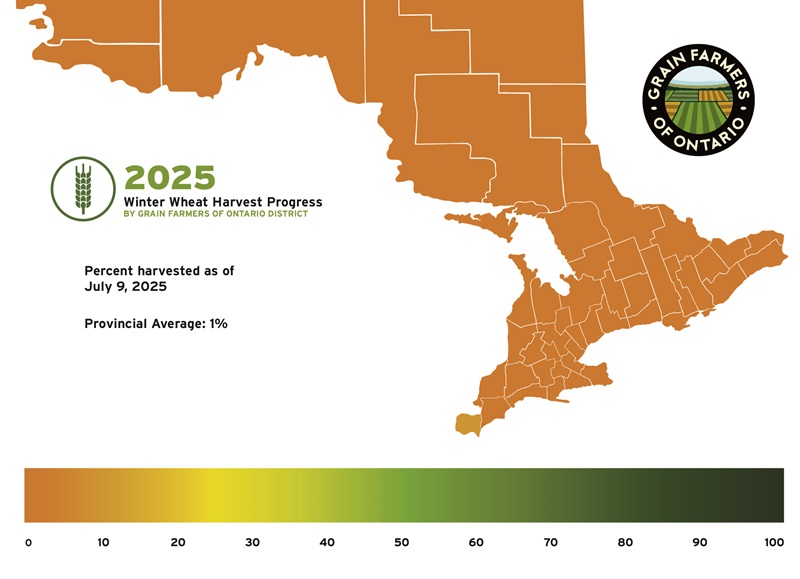
Field Progress
Explore the newly launched Field Progress page from Grain Farmers of Ontario. This page provides weekly updates on planting and harvest progress across the province, broken down by district. Currently, it features the latest insights into winter wheat harvest progress across Ontario. As the year progresses, Field Progress will also highlight spring cereal, soybean, and corn harvest progress.
July 3, 2025
Crops continue to progress as the calendar turns to another month. Be on the lookout for insects and disease, and take preventative measures to avoid yield impacts. Now is also the time to consider cover crop options for after the cereal crop harvest.
Corn
Corn is progressing very well with some heat and moisture, staging V7 to V10, with many fields knee high and canopying over.

https://apsjournals.apsnet.org/doi/full/10.1094/PDIS-02-20-0449-FE
As crops progress, now is a good time to look at fields overall. Are there areas of the field that are visually less than ideal? Now is a great opportunity for growers to dig up plants and identify the differences between the good sections of the field and the poorer sections of the field to help identify possible concerns. Make notes, so when harvesting and watching the yield monitor in the fall, you can quickly identify if it was the planting conditions restricting yield or maybe something else. Good information leads to good decisions.
One disease that should be on everyone’s watch list this year is tar spot. The ideal conditions for developing this disease are temperatures between 15 and 21 °C and high humidity (greater than 75 per cent) for seven to eight hours. Saturated soils (like many areas are seeing) and leaf wetness can cause the disease to spread quickly. Overall, it is wet/dry cycles that seem to drive development. Tar spot has been “spotted” already in the U.S. this year. It has historically been identified in Ontario in the first half of July. For more information on this disease and how to manage it, read the Grain Farmers of Ontario tar spot factsheet. The Crop Protection Network, supported by Grain Farmers of Ontario, also has a tar spot Crop Risk Tool that can help identify high-risk weather conditions.

Overall, as fungicide timing approaches and with the threat of tar spot (especially in areas that have experienced significant infections and yield losses), it is key to talk to retailers and schedule a fungicide application, as there are only so many sprayers and aerial applicators available in a very short window. There is always the opportunity to say no and pass on an application, but it is very hard to get added to a list as application timing approaches.
Keep in mind in the coming weeks as tassels start to emerge to scout for Bt resistant European Corn Borer (ECB). ECB is a destructive pest that has recently seen Bt resistant populations in regions of Canada.
Review this past GrainTALK webinar on other diseases and pests to be on the lookout for.
Soybeans
Soybeans across the province are staging V5 to V6 up to the R1 to R2 stage. Stage R2, where there is an open flower on one of the top two nodes on the main stem, is full bloom. Plants will typically stay in the R2 stage for eight to 12 days, at which time small pods will begin to form, transitioning the soybean into the R3 stage. Pay attention to areas that were waterlogged from past rainstorms; signs of wet roots may show up as the bottom leaves turn yellow or soybeans die. Excessive moisture can create uneven fields as low areas and compacted areas cannot achieve proper gas exchange in the root zone. Expect disease pressure to increase significantly in a short time frame.
Fungicide applications are occurring or will shortly if farmers choose to do so. Farmers are applying fungicides to help manage disease and potentially increase crop yield. Many fungicide applications are to help control white mould, which can affect the yield of soybeans. Certain varieties are more prone to infection, as are fields that were planted early, have a narrow row width, and have high plant populations. More information on white mould can be found here.
Be sure to check out the Pest Manager app (developed by OMAFA with funding from Grain Farmers of Ontario), which allows you to identify, map, and find integrated management options for common weeds, insects, and diseases in corn, soybeans, and cereal crops. Any pesticide use information in the app is specific to Ontario only, and users should always read the product label before use.
Read more about the challenging weeds of Palmer Amaranth and Waterhemp.
With wheat harvest just around the corner, double-crop soybeans are a common conversation in some areas. If aiming for double-crop soybeans, seed supply on early season beans will be needed. The date of wheat harvest and the field location will determine a lot. Aim for seed maturity that is at least one full maturity group shorter but check with your seed dealer on what they suggest and what is available. The seeding rate should be increased to at least a population of 250,000 seeds per acre. Planting date should be considered, looking at frost dates, as the yield potential will drop considerably if soybeans are planted too late; early to mid-July planting dates are ideal. Be sure that the soybeans are going into good conditions. Getting soybeans in timely is critical, July 10 is a good date for wrapping up second crop soybean planting in the southwest, maybe July 20 in the deep southwest, but it is a risk at any date as success will be determined by weather conditions allowing for quick emergence and proper rains for plant development before the first frosts. The management of straw is critical; be sure to spread straw evenly. If you are considering baling, realize that the time spent baling might keep you out of the field planting for a couple of days. If you plan to double crop soybeans, plant to moisture, up to three inches in July, as they will push through. If there is no moisture at that level, aim for one inch planting depth and hope for rain.
The need for weed control in double-crop soybeans will be less; in theory, one pass would still be needed to control weeds. Most annual weeds emerge during May and June. If double-crop soybeans are planted in July, weed pressure should be considerably less. Limit the investment in weed control as the chance for good soybeans is less likely, with much relying on the weather cooperating for a good yield and harvest so late in the season.
Cereals
Spring cereals are in stem elongation to heading stages.

Winter wheat fields are staging anywhere from GS 75 (milk) to GS 92 (ripe). When kernels are in the dough stage, they reach their maximum dry weight and are physiologically mature when the peduncle turns yellow. The kernel moisture drops from roughly 40 per cent to 30 per cent.
Winter wheat harvest will begin soon, as fields in the southwest are just needing the crop to dry down. Warm, dry weather will help ripen the grain. As harvest approaches, monitor fields closely for fusarium, and aim to harvest impacted fields first, and keep separate from fields that are not impacted by the disease. Ideally, if the field has been identified as containing Fusarium-damaged kernels, get the crop off as soon as it is mature, as nothing good comes from waiting. Also, if fields have been lodged, monitor and harvest first as well.
In preparation for harvest, watch this past GrainTALK webinar on harvest prep and maximizing your combine’s efficiency.
Cover Crops
Now is the time to be planning for cover crops once the cereal crop has been harvested. Cover crops can help meet several goals such as increase organic matter, suppress weeds, prevent erosion and more. The Cover Crop Selector Tool gives cover crop recommendations while taking into consideration individual field goals. This tool is based on Ontario research and is supported by Grain Farmers of Ontario.
June 26, 2025
Crops are progressing nicely, and some corn fields will certainly reach knee high by the first of July. Disease and pests are still causing challenges across the province. Be sure to monitor and act when warranted.
Corn
Corn across the province is in the V5 to V9 stage. By about the V5/V6 stage (five to six visible leaf collars, or seven to nine full leaves), the tassel is initiated along with the harvestable corn ear. At around the V10 stage, if you remove the leaves from the stalk, including the leaf sheaves, you should be able to see some identifiable ear shoots! Now is the time not to cause any plant stress, as it will affect the ear development.
The number of kernel rows is determined on the main ear shortly after V5 to V6. The number of kernel rows is largely driven by plant genetics (maximum row number) but is influenced by the environment.
Tar spot is beginning to rear its ugly head again in the U.S., with the disease being identified as close as Indiana so far this year. In past years, tar spot has typically been identified in Ontario within the first two weeks of July.
A new tool is now available to help predict the risk of tar spot (to be used once the crop has reached V10) and northern corn leaf blight in Ontario. The Crop Risk Tool provides weather-based forecasting and risk assessments for various crop diseases (including tar spot and northern corn leaf blight), helping farmers to make data-driven decisions. The tool allows users to select the crop, location, planting date, and more to create a risk assessment. Even though this tool has been tested, visual scouting is still recommended. This tool is a Crop Protection Network (CPN) resource, which Grain Farmers of Ontario sponsor. For more information on tar spot identification, favourable conditions and control, view this Grain Farmers of Ontario factsheet.
Soybeans
Overall, soybean fields are looking good, with some fields canopying. This past week’s warmer weather has increased growth; soybean plants can be found around V4 (four trifoliates) to V6 (six trifoliates) to R1 (beginning bloom-plants have at least one open flower at any node) stages. Flowering begins on the third to sixth node of the plant and continues up and down the stem, and then to the branches. Three to four days after an individual flower opens, the flower petals dry out, and the pod begins to form.
Excessive rains in some areas last week created flooding and water ponding. With excessively wet soils, keep an eye out for root diseases, such as rhizoctonia and fusarium, that potentially affect these fields. Tolerant varieties should give good defence, but standing water will affect these plants. More information on identifying these two root rots can be found here.
Be sure to check out the Pest Manager app (developed by OMAFA with funding from Grain Farmers of Ontario), which allows you to identify, map, and find integrated management options for common weeds, insects, and diseases in corn, soybeans, and cereal crops. Any pesticide use information in the app is based on research from Ontario, and users should always read the product label before use.
Some challenging weeds are being identified in fields. Read more about Palmer amaranth and waterhemp.
Fungicide timing is approaching for white mould control. The key to getting the most out of fungicide applications is timing. Risks for white mould include the field history; if there is a known history of white mould, then the chance of it reoccurring is high. Variety, row spacing, plant density, and how quickly the field will canopy all factor into the likelihood of infection. Weather patterns will also help determine the risk. When it is foggy/humid, and moisture is on the plant most of the day, there will be a higher risk of white mould. Listen to what Horst Bohner, OMAFA soybean specialist, shares on white mould last fall as he looks forward to this year and white mould concerns in this GrainTALK Webinar (around the 16:23 mark). The Sporecaster App can help you determine your field’s risk level. Fungicides can lower the severity of infection; however, timing is critical. The timing of application ranges from R1 (single flower on the main stem) to R3 (pod on the main stem). Be sure to speak with your agronomist for optimum timing and product selection, and always follow label recommendations.
Soybean aphids are sometimes found in fields around this time of the year. Typically, aphids found earlier in the season will build up populations through the year. Although weather can alter the population, more importantly, is the population of beneficial insects such as ladybugs. If aphids are identified, also take note of the beneficial insects. The Aphid Advisor app is a great resource for identifying if the action threshold has been reached.
Cereals

is found just below the wheat head.
The winter barley harvest is expected to begin in the next few weeks.
Fields are moving closer to harvest, with fields staging up to the dough stage (GS 80 to 87). Growth stage 87 is hard dough and is physiological maturity. Physiological maturity is when the peduncle of the wheat plant turns yellow, the kernels have reached this maximum dry weight at this point. With these past warm days, the grain fill period will be shortened. Ideally through the grain fill period, cool nights are experienced to help slow the maturation of the crop. Some rain later on this week would also be ideal to help with kernel sizing, as there are cracks in wheat field soil from the crop sucking up moisture.
In winter wheat fields that were not sprayed with a T3 fungicide, scouting should be taking place to access levels of fusarium infection in fields. If high rates of infection are noted, harvest those fields first.
Spring cereals are heading out right now. Be sure to scout for stripe rust as it was present in winter wheat due to overwintering in the area. If there is stripe rust present in fields, please connect with Joanna Follings, OMAFA cereals specialist, as she is collecting stripe rust samples for analysis.
Cereal leaf beetles are being found in fields, at threshold levels with spraying occurring in pockets across the province. For more on this pest and threshold levels read additional info here.
Cereal aphids that were found in winter wheat are moving to spring cereals, infection from the insect can cause barley yellow dwarf virus (BYDV) in cereal crops. The Cereal Aphid Manager App can help with a decision on whether to take action. Always read and follow product labels, paying particular attention to pre-harvest intervals.

During this these past couple of weeks, the Ontario Cereal Crop Committee winter wheat trials are being inspected during the final stages of grain fill by collaborators and sponsors. Inspections are indicating large differences in variety tolerances to the disease pressure this year. Leaf rust, stripe rust and BYDV are the key diseases showing up. Trial results will go live on GoCrops.ca later this summer. Are you interested in learning more about the wheat breeding process? Read more here.
Managing drift
Join Dr. Jason Deveau, in this GrainTalk webinar, as he shares insights on off target pesticide movement, strategies to limit movement, and more. You can also visit www.bedriftaware.ca for more information on reducing spray drift.
Proper clean out for harvest to avoid grain contamination from treated seed
A reminder that grains or oilseeds contaminated with treated seed or other foreign material put domestic and export grain markets at risk. Using equipment that has handled treated seed can be a leading source of contamination. Read more about reducing the risk of contaminated seed in this Grain Farmers of Ontario factsheet.


